JUICE (Jupiter Icy Moons Explorer)
Non-EO
ESA
NASA
Planned
JUICE satellite mission is a part of ESA's Cosmic Vision 2015-2025 programme. It will observe Jupiter and its moons.
Quick facts
Overview
| Mission type | Non-EO |
| Agency | ESA, NASA |
| Mission status | Planned |
JUICE (Jupiter Icy Moons Explorer)
Spacecraft Development Status Launch Sensor Complement References
JUICE is the first large-class mission in ESA's Cosmic Vision 2015-2025 program. JUICE will spend at least three years making detailed observations of the giant gaseous planet Jupiter and three of its largest moons, Ganymede, Callisto and Europa. 1) 2)
Science objectives: The focus of JUICE is to characterize the conditions that may have led to the emergence of habitable environments among the Jovian icy satellites, with special emphasis on the three ocean-bearing worlds, Ganymede, Europa, and Callisto. Ganymede is identified for detailed investigation since it provides a natural laboratory for analysis of the nature, evolution and potential habitability of icy worlds in general, but also because of the role it plays within the system of Galilean satellites, and its unique magnetic and plasma interactions with the surrounding Jovian environment. JUICE will determine the characteristics of liquid-water oceans below the icy surfaces of the moons. This will lead to an understanding of the possible sources and cycling of chemical and thermal energy, allow an investigation of the evolution and chemical composition of the surfaces and of the subsurface oceans, and enable an evaluation of the processes that have affected the satellites and their environments through time. The study of the diversity of the satellite system will be enhanced with additional information gathered remotely on Io and the smaller moons. The mission will also characterize the diversity of processes in the Jupiter system that may be required in order to provide a stable environment at the icy moons on geologic time scales, including gravitational coupling between the Galilean satellites and their long term tidal influence on the system as a whole. JUICE will carry out extensive new studies of Jupiter's atmosphere, magnetosphere and their interaction with the satellites to further enhance our understanding of the evolution and dynamics of the Jovian system. 3) 4) 5)
Background
In 2012, ESA selected the JUICE mission over two other candidates: NGO (New Gravitational wave Observatory), to hunt for gravitational waves, and ATHENA (Advanced Telescope for High-Energy Astrophysics). 6)
Jupiter's diverse Galilean moons – volcanic Io, icy Europa and rock-ice Ganymede and Callisto – make the Jovian system a miniature Solar System in its own right. With Europa, Ganymede and Callisto all thought to host internal oceans, the mission will study the moons as potential habitats for life, addressing two key themes of Cosmic Vision: what are the conditions for planet formation and the emergence of life, and how does the Solar System work? JUICE will continuously observe Jupiter's atmosphere and magnetosphere, and the interaction of the Galilean moons with the gas giant planet.
JUICE will visit Callisto, the most heavily cratered object in the Solar System, and will twice fly by Europa. JUICE will make the first measurements of the thickness of Europa's icy crust and will identify candidate sites for future in situ exploration.
The spacecraft will finally enter orbit around Ganymede in 2032, where it will study the icy surface and internal structure of the moon, including its subsurface ocean. Ganymede is the only moon in the Solar System known to generate its own magnetic field, and JUICE will observe the unique magnetic and plasma interactions with Jupiter's magnetosphere in detail.
Today's announcement is the culmination of a process started in 2004 when ESA consulted the wider scientific community to set Europe's goals for space exploration in the coming decade.
Planned Journey of JUICE
• May 12, 2020: Jupiter's moon Europa is a fascinating world. On its surface, the moon appears to be scratched and scored with reddish-brown scars, which rake across the surface in a crisscrossing pattern. These ‘scars' are etched into a layer of water ice, which is thought to be at least several kilometers thick and covering a vast – and potentially habitable – subsurface ocean. 7)
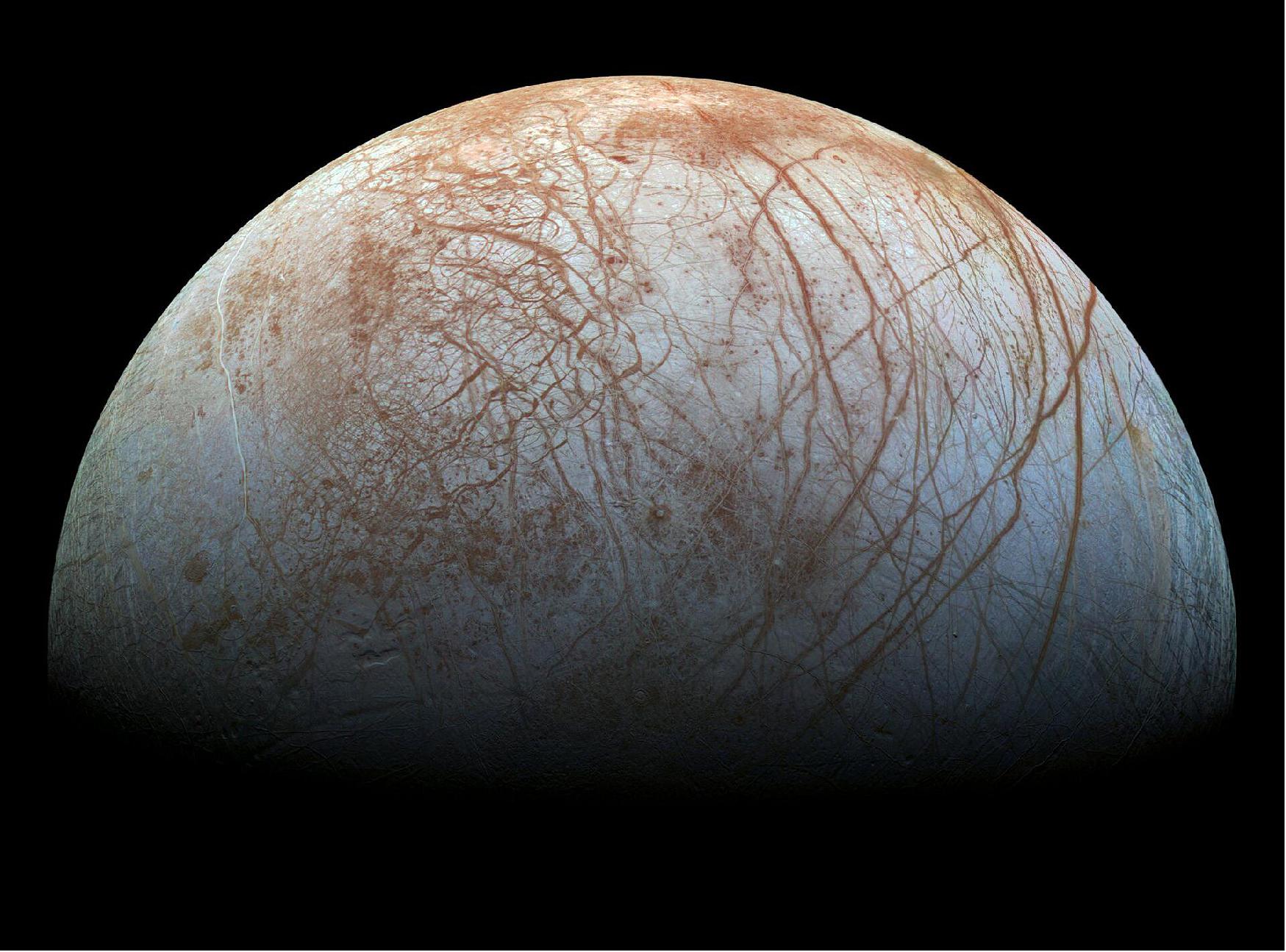
Scientists are keen to explore beneath Europa's thick blanket of ice, and they can do so indirectly by hunting for evidence of activity emanating from below. A new study, led by ESA research fellow Hans Huybrighs and published in Geophysical Research Letters, did exactly this. Building on previous magnetic field studies by Galileo, the simulation-based study aimed to understand why fewer than expected fast-moving protons – which are subatomic particles with a positive charge – were recorded in the vicinity of the moon during one of the flybys of the moon performed by the Galileo probe in the year 2000. 8)
Researchers initially put this down to Europa obscuring the detector and preventing these usually abundant charged particles from being measured. However, Hans and colleagues found that some of this proton depletion was due to a plume of water vapor shooting out into space. This plume disrupted Europa's thin, tenuous atmosphere and perturbed the magnetic fields in the region, altering the behavior and prevalence of nearby energetic protons.
Scientists have suspected the existence of plumes at Europa already since the times of the Galileo mission, however indirect evidence for their existence has only been found in the last decade. Excitingly, if such plumes are indeed present, breaking through the moon's icy shell, they would offer a possible way to access and characterize the contents of its subsurface ocean, which would otherwise be hugely challenging to explore.
These prospects are of great interests to ESA's upcoming Juice mission, to investigate Jupiter and its icy moons. Juice will carry the equipment needed to directly sample particles within the moon's water vapor plumes and also to detect them remotely, aiming to reveal the secrets of its vast, mysterious ocean.
Scheduled to arrive in the Jupiter system in 2029, the mission will study the potential habitability and the underground oceans of three of the giant planet's moons – Ganymede, Callisto and Europa. As this new study demonstrates, tracing the energetic charged and neutral particles in Europa's vicinity offers huge promise in efforts to probe the moon's atmosphere and wider cosmic environment – and this is precisely what Juice plans to do.
Olivier Witasse, ESA's Juice project scientist, is also a co-author on the study, along with a number of ESA research fellows, including former Science Directorate fellows Lina Hadid and Olivier Lomax, Mika Holmberg, a research fellow in the Technology, Engineering and Quality Directorate.
The new study is based on data collected by Galileo during a flyby of Europa in 2000. The image comprises data acquired by the Galileo Solid-State Imaging (SSI) experiment on the spacecraft's first and fourteenth orbits through the Jupiter system, in 1995 and 1998, respectively, and was recently re-processed in 2014. The image scale is 1.6 km/pixel, and the north pole of the moon is to the right.
Main Requirements of the Spacecraft Design (Ref. 2)
Radiation mitigation: The radiation environment is dominated by the bound electrons in the Jupiter magnetosphere. Their fluence is dominating over the solar proton contribution by several orders of magnitude. The electron spectrum also has a high energy component, which extends to higher energies than exposed to in geo-stationary. At low energies of the electron spectrum, the expected total mission fluence is actually lower than a typical exposure for 10–15 year geostationary mission. Such electrons are predominantly absorbed at the surface, and therefore heritage is available of materials withstanding such doses. For the surfaces of the spacecraft, standard mitigation strategies for geostationary applications will be used, such as coating with conductive layers.
For the considerations of shielding the benefit of units shielding each other has been considered and evaluated with detailed radiation transport simulations. The required radiation tolerance was set at 50 krad at the outside of each unit.
Power: The other main mission drivers are related to the large distance from the Sun, and the requirements that the mission generate power by solar cells. The worst case solar intensity is 46 W/m2. Together with detailed analysis of all critical mission phases, the requirements on the power generation were obtained resulting in a solar array area of close to100 m2. This solar array size can only be obtained when eclipses in the final phases of the mission around Ganymede were excluded. Furthermore, when in Ganymede's orbit, the normal incidence of the sunlight onto the solar arrays will be maintained through one-axis solar array drive mechanisms combined with a rotation of the spacecraft around the nadir axis. It is however foreseen that this yaw steering could be paused for a limited period of time, e.g. in support of high resolution imaging.
Thermal: The entire spacecraft will be optimized for operations in the cold environment at Jupiter and will be covered by MLI (Multi-Layer Insulation). The albedo heating from the Jupiter moons is negligible. During the Venus gravity assist, the high gain antenna will be used as sun-shield, so as to avoid forcing the spacecraft design to also accommodate for this hot case in full. Passive thermal control will be achieved with radiators; only electrical heating will be provided.
Propulsion: The orbit insertions at Jupiter and Ganymede, the reductions of the altitude of the orbit around Ganymede, and the large number of gravity assists and flyby maneuvers (>25) lead to a high Δv requirement, and consequently to a high wet/dry mass ratio (about 2.6:1). The spacecraft architecture will therefore need to include large volume of propellant tanks.
Communications: The large distance to Earth results in a signal round trip time of up to 1h 46 minutes requiring careful pre-planning and autonomous execution of operations by the spacecraft. Additionally, a high gain antenna is required for data downlink. The data downlink system is sized for an average daily data volume of at least 1.4 Gbit, assuming maximum telecommunication pass of 8 h/day.
AOCS (Attitude and Orbit Control Subsystem): The AOCS is driven by the need for maintaining nadir pointing of the spacecraft during flybys for observations with the scientific instruments. In addition the spacecraft has a large angular inertia mainly due to the large area of the solar panels. The remaining deployable appendices (sub-surface radar antenna and magnetometer boom) add constraints on the pointing stability.
The attitude will be provided through the use of momentum wheels, supported by a propulsion system for off-loading. Off-loading will be scheduled outside science observation windows.
Avionics: The avionics subsystem provides for sufficient command storage to enable the required autonomy of operations. A storage for several days of science data will be included to provide sufficient flexibility such that the spacecraft can be pointed according to the needs of the science instrumentation, and buffer the data for downlink later.
Mechanisms: Mechanisms include the solar panels, the solar array drive mechanisms, the sub-surface radar boom, the magnetometer boom and the RPWI antennae. The appendices will be accommodated such that their deployment can be performed independently, and that they do not infringe the field-of-view of the optical and particle instruments, including stray light avoidance cones.
Planetary Protection
The mission will include a limited number of flybys of Callisto, Ganymede and Europa, and will then finally go into orbit around Ganymede and will be disposed on Ganymede's surface. The highest Planetary Protection Category targets are Europa and Ganymede.
Europa is a Planetary Protection Category III target ("chemical evolution and/or origin of life interest or for which scientific opinion provides a significant chance of contamination which could jeopardize a future biological experiment"). The mission therefore either needs to demonstrate that the likelihood of collision with Europa is <10–4, or undergo active bioburden reduction to meet the requirement that the probability of inadvertent contamination of the Europa ocean is <10–4. The first option was taken as the baseline for proceeding. The risk of collision with Europa is limited to the period up to the Europa flybys. After this period the spacecraft has a perijove higher than Europa's orbit and a lower apocenter, such that collisions are sufficiently unlikely within the timeframe of concern (several 100 years). A dedicated study was performed analyzing the likelihoods of impact, in case of spacecraft failures after each maneuver. Depending on the time and location of the maneuver, this ranges from below 5% to 40% (only for the case of the Europa flyby) for the duration during which it was estimated that the spacecraft would be sterilized by radiation (200 years). Consequently an allocation for the reliability of the spacecraft against total loss was allocated including a margin of at least a factor of two. A preliminary bottom-up assessment of spacecraft's subsystem reliabilities taking into considerations the lifetime and the exposure to the environment indicated that the overall allocated spacecraft reliability can be met. As for short term failures, i.e. loss of spacecraft control during approach for the Europa flyby, a re-targeting strategy will be performed: the spacecraft trajectory will be implemented such that Europa always remains outside the 3σ uncertainty, and small correction maneuvers be performed during the approach (step-in procedure).
Ganymede is a Planetary Protection Category II target ("significant interest relative to the process of chemical evolution and the origin of life, but only a remote chance that contamination by spacecraft could compromise future investigations"). For Ganymede the bio-burden brought to it shall be controlled and limited such that the likelihood of one active organism reaching the Ganymede subsurface ocean shall be <10–4. For the calculation of the likelihood of bringing a surviving organism to the Ganymede subsurface ocean, the recommendations in [D-3] are followed, and it is largely reduced by the assumption of the low probability of the burial mechanism (10–4) and by the low likelihood of landing in an active region (2 x 10–3). Further factors, such as the estimated cruise survival fraction (10–1), sterilization through radiation (10–1), and probability of survival during transport on the surface (10–2), bring the total likelihood to 2 x 10–11. Assuming a typical bioburden at launch around 106 based on the assumption of equipment exposure to a standard clean room environment, the requirement of 10–4 would be met by a factor of 5.
Consequently, apportionment and monitoring of the bioburden will be required during the mission implementation, by break down and allocation of allowed budgets to each hardware supplier, including payload. Monitoring will be achieved through essays taken at regular intervals.
Furthermore, collateral probability of contamination of alternative critical bodies, such as Mars by any part of the flight segment, including any part of the launch vehicle within 50 years shall be smaller than 10–2. Some launch opportunities consider Mars gravity assists, and it will be demonstrated for these that neither the spacecraft nor any part of the launcher will impact Mars within this timescale. Early assessment confirmed this assumption.
Ground Segment and Operations
The JUICE mission will be planned and operated by ESA. The ground segment will consist of the Mission Operation Center (MOC) and the Science Operation Center (SOC). The JUICE Science Ground Segment (SGS) is made of the SOC and of the PI instrument teams and will be implemented according to the guidelines described in the Science Management Plan.
The S/C will be operated by an off-line monitoring and control approach. A pre-scheduled timeline (planned sequences of operations, defining S/C or instrument activities) will be uploaded by the MOC at regular intervals and stored on-board. During the nominal science operations, the ground station contact will happen daily, and will be used to upload new S/C and instrument commands, as well as to retrieve the scientific data together with the housekeeping data (for the S/C and instruments). No routine science operations are foreseen in the mission baseline scenario during the cruise phase.
The JUICE SGS is responsible for performing the science operations related to the implementation of the high-level science activities designed by the SWT (Science Working Plan).
Science operations encompass two main groups of activities, called hereafter the Uplink or Downlink side of Science Operations.
The Uplink activities are related to the generation of an instrument operations timeline to be uplinked to the Spacecraft. The SOC and the PI teams will consolidate and validate the science operations requests from individual instrument teams into an instrument operation timeline delivered to the MOC before being uplinked onboard the spacecraft.
In case of non-routine operations (reference measurements during the Earth and Venus flybys during the cruise phase) the SOC will assist the instrument teams in generating Pointing Timeline Request (PTR) files and delivering the instrument commanding directly to the MOC.
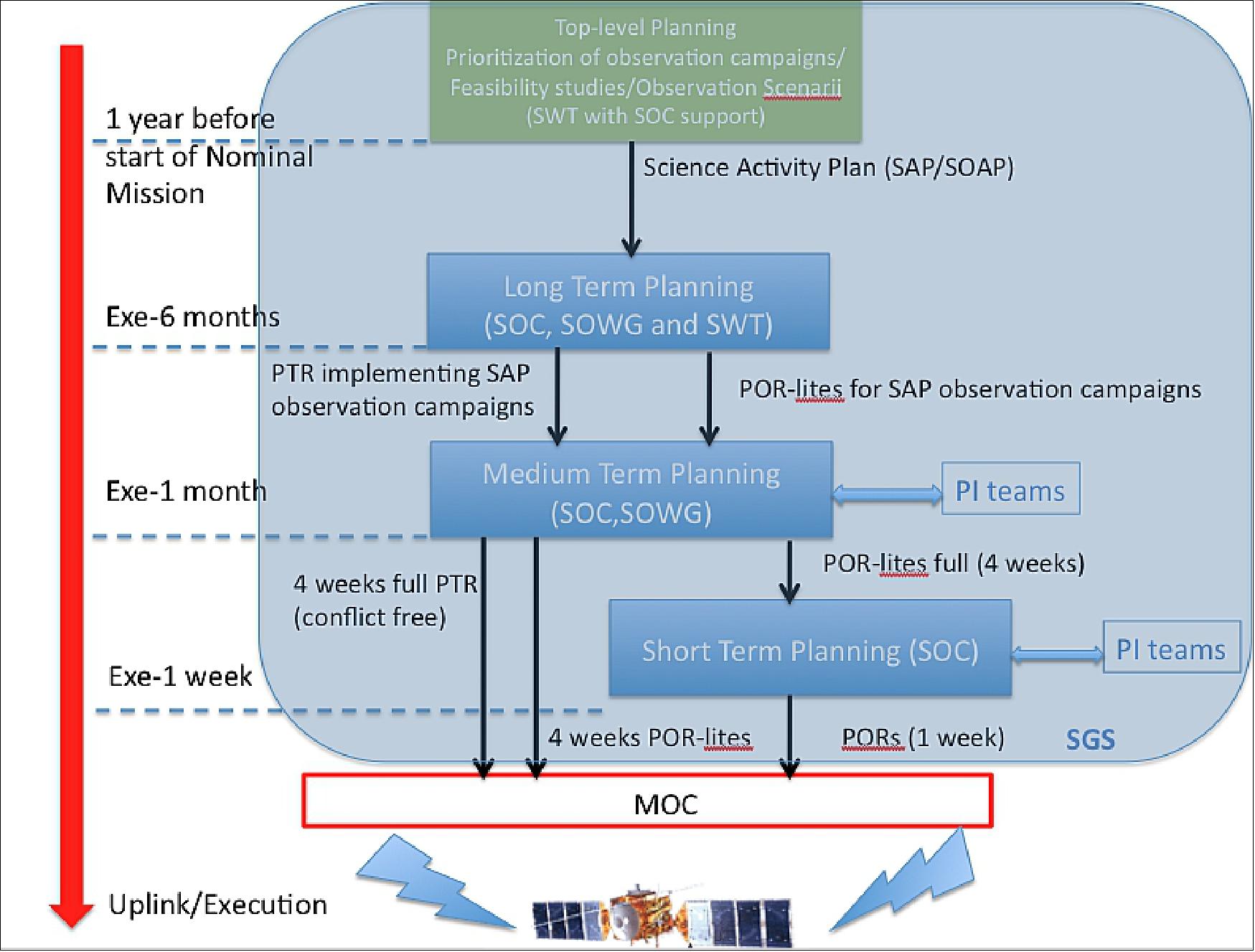
The nominal science operation planning will be divided in three steps. The first step is the Long Term Planning (LTP) covering 6 months of mission, addressing in more details the top-level planning with a refined knowledge of the S/C resources and constraints. The next step is the MTP (Medium Term Planning) performed on a monthly basis. The main goal of the MTP phase is the finalization of the integration of the observations pointings as well as the validation of the associated instrument modes against the latest knowledge of S/C available resources, constraints and flight rules. The output of this phase is a frozen PTR (Pointing Timeline Request) file. The last step is the STP (Short Term Planning), performed on a weekly basis, whose main goal is the finalization of the instrument commanding.
Downlink activities encompass all data handling and archiving tasks, from retrieval of instrument telemetry and auxiliary data from the DDS (Data Disposition System) under MOC responsibility and all subsequent processing to higher data levels, as well as quick look checks of the performed observations. Data archiving is performed at different levels of the data processing chain.
The SOC will process the telemetry data and distribute the resulting raw data to the instrument teams and to the archive. The raw data processing (telemetry into uncalibrated science data) is centralized at the SOC. Raw data product will be made available to the instrument teams about 4 hours after the telemetry packets are available on the DDS. Immediately after the data becomes available in the DDS, SOC retrieves, verifies and processes all spacecraft and instrument related telemetry (house-keeping and science data) obtained from the DDS. Telemetry integrity (science packets) will be checked by SOC. In addition, SOC retrieves any auxiliary data needed for science data processing, in particular the data from Flight dynamics: reconstructed spacecraft trajectory and attitude.
The instrument teams have the responsibility to generate their calibrated data and distribute them to the archive and follow the general requirements for science data archive format (PDS4). All calibration products (software, procedures and calibration files) must be delivered by the PI teams to the SOC and archived as PDS4 products. The SOC works closely with the instrument teams to facilitate the generation of these products in PDS compliant formats, thereby minimizing the additional effort required for this activity.
Spacecraft
Airbus is developing and building JUICE (JUpiter ICy moons Explorer) spacecraft for the European Space Agency, which will study Jupiter and its icy moons. In July 2015, the company was selected by ESA (European Space Agency) as prime contractor for the design, development, production, and testing of a new spacecraft named ‘JUICE'. As prime contractor, Airbus will employ 150 people and lead a consortium of more than 60 companies during the course of the project. 9)
In May 2022, JUICE will begin a 7.6 year cruise to Jupiter to spend three and a half years in the Jovian system. Its main mission will be to explore the huge planet's three largest icy moons in the hope of determining whether life is possible on these dwarf planets. What if extra-terrestrial life does exist? For centuries, this question – which both fascinates and frightens mankind – has remained unanswered. But by the year 2030, answers to the questions: how do planets form? how does life emerge? how does the solar system work? may well have been found.
It will take JUICE seven and a half years to travel the almost 600 million kilometers to the gas giant. Once the spacecraft enters Jupiter's gravitational field, the first two and a half years of its three-and-a-half-year mission will be spent making about 30 observation overflights of the three moons, observing examining gravity and magnetic interactions, amongst other things. The last year will be spent in orbit around Ganymede to observe this moon in much greater detail.
The challenges are enormous. JUICE must deal with very low and very high temperatures as it will circle Earth, Mars and Venus for gravity assist maneuvers to build up enough speed to reach Jupiter's orbit. Jupiter's cold environment also makes it hard to collect energy. "The goal is to investigate whether there are liquid oceans under these icy crusts which might harbor organic components or even life" says Vincent Poinsignon, JUICE project manager.
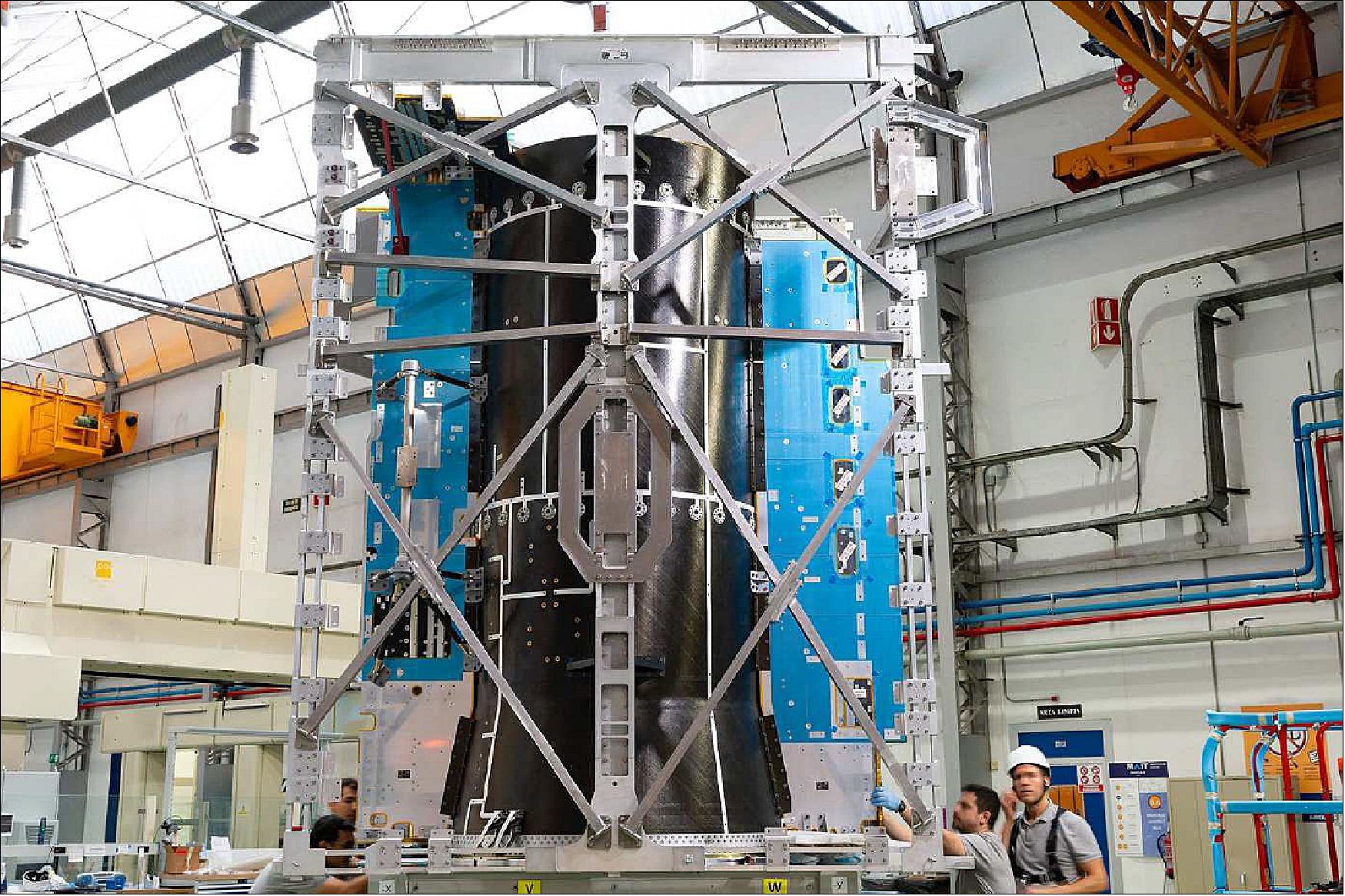
The JUICE spacecraft is a 3-axis stabilized platform that will accommodate 10 instruments. The power subsystem consists in a solar array with two wings of five panels each for a total surface of 97 m2 providing ~820 W at Jupiter (end of life conditions), and a Li-ion battery. 11)
A 2.5 m diameter High Gain Antenna, using X- and Ka- bands, will ensure telemetry/telecommand links for routine operations, safe-mode, and radio science related investigations. At least, 1.4 Gbits of scientific data will be downloaded every day.
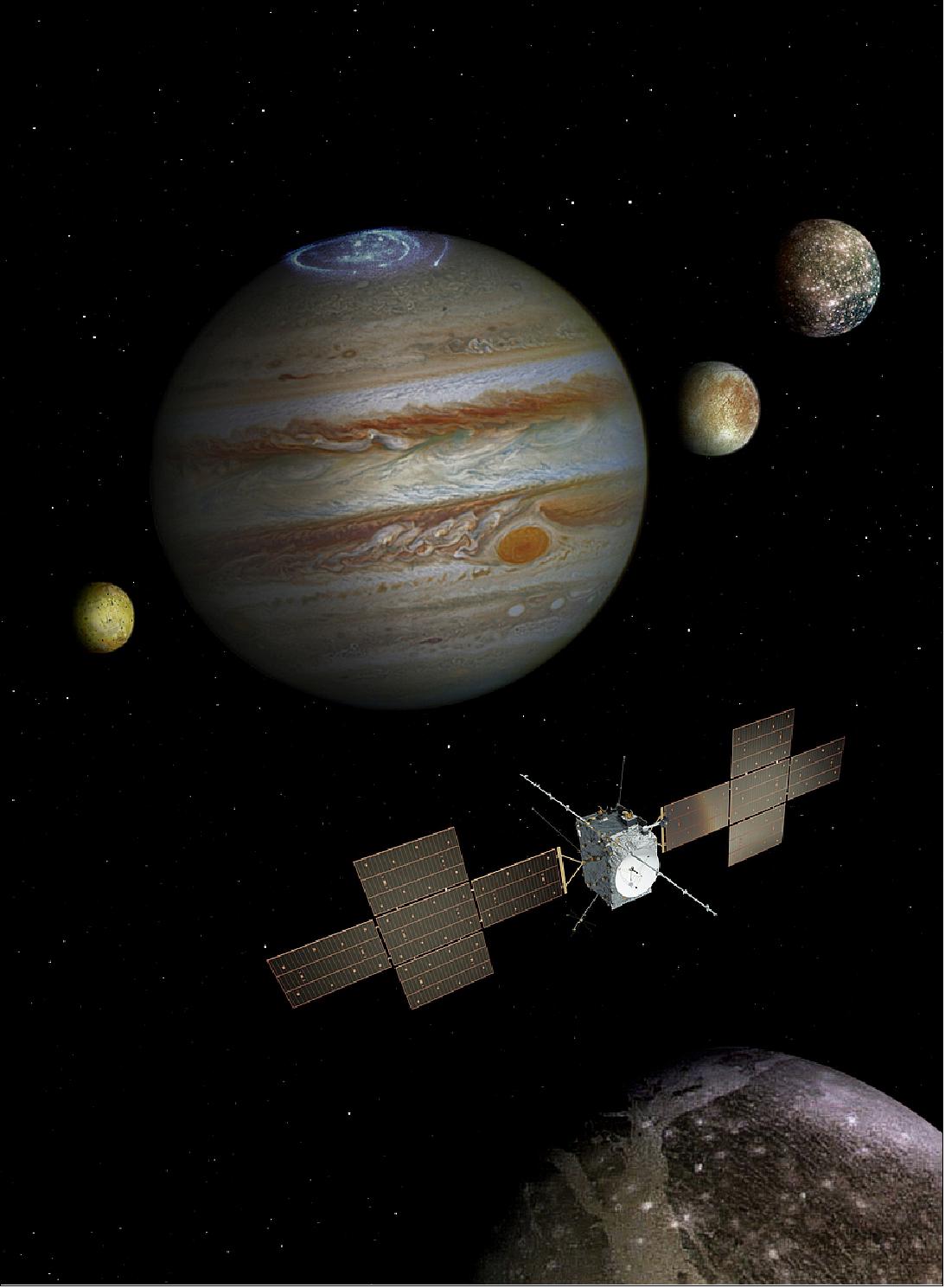
The propulsion system is a bi-propellant main engine plus a set of 10 thrusters. The two main mission maneuvers are the Jupiter and Ganymede orbit insertions. Two vaults will provide to some electronics a shielding against the harsh Jupiter radiation environment, as well as adequate thermal conditions.
The spacecraft includes deployable appendices such as a 10.6 m boom supporting J-MAG (JUICE Magnetometer) and RPWI (Radio and Plasma Wave Instrument) sensors, a 16 m radar antenna, and a steerable medium gain antenna used for communication and radio-science investigations.
PVA (Photovoltaic Assembly) for JUICE: The PVA design, development and verification (DD&V) foresee a thorough development, design verification and qualification activities along with associated test samples. 13)
The development of the JUICE PVA is progressing. A number of issues have been identified and recovery / alternative plans put in place to identify solutions. A robust baseline design is under final consolidation and will be available by the third quarter of 2018 allowing the release of all qualification campaigns.
Development Status
• June 7, 2022: On 19 June 2022, Jupiter's intriguing moon Europa will pass in front of a distant star, making that star appear to disappear for at least a minute. This event will be easy to see with any size of telescope from certain parts of Africa. 14)
- By timing the event and then comparing the observations from different viewing locations astronomers will be able to refine their understanding of Europa's orbit in preparation for ESA's JUpiter ICy moons Explorer (Juice) mission, which is scheduled to arrive at the system during 2031. They may also be able to investigate the way the starlight interacts with the tenuous envelope of gasses that surround Europa.
- When one celestial object blocks the light of a more distant one, it is called an occultation. The prediction for this particular occultation has been made using data from ESA's Gaia mission.
- Operational since late 2013, Gaia is a star mapping mission that is recording the precise positions of more than a billion stars in our home galaxy, the Milky Way. On 13 June, its much anticipated third full data release (DR3) will be made publicly available.
- DR3 will contain almost 2 billion celestial objects. Using data from previous Gaia releases has already allowed improved predictions to be made for several previous occultations, increasing the chances of observational success.
- For example, in 2017, Gaia data was used to predict a Europa occultation that was to occur on 31 March. At the time, the only Jovian moons that had been observed in this way were Io and Ganymede. So, thanks to Gaia's prediction, astronomers on Earth observed a Europa occultation for the first time.
- Gaia data were subsequently used to predict further occultations involving all four of Jupiter's largest moons. Known as the Galilean moons because they were discovered by Galileo Galilei, they are Io, Europa, Ganymede and Callisto.
- What makes the upcoming occultation of Europa special is that this moon will be in Jupiter's shadow at the time and so it is impossible to see Europa directly because it does not generate any light of its own. Instead, it is visible only when it reflects sunlight. As Jupiter will be blocking that sunlight during the occultation, observers will only know Europa is there when it makes the star temporarily disappear.
- The occultation takes place at 03:05:57 UTC, and it is only visible across a rather narrow track of the Earth's surface. The centre line of that track passes through the African countries of Namibia, Botswana and Zimbabwe. Eastwards from here, it will be lost from view by the rising Sun.
![Figure 5: Jupiter's moon Europa to obscure distant star. The occultation takes place at 03:05:57 UTC, and it is only visible across a rather narrow track of the Earth's surface. The centre line of that track passes through the African countries of Namibia, Botswana and Zimbabwe. Eastwards from here, it will be lost from view by the rising Sun. The occulted star is below the limits of visibility to the naked eye but is not too faint. With an apparent brightness of magnitude 9, it will be easily visible in any size of telescope. To find it on the sky, astronomers should look at coordinates RA: 00:23:46.52, Dec: +01:13:18.92 [image credit: Josselin Desmars (IPSA/IMCCE)]](https://www.eoportal.org/ftp/satellite-missions/j/JUICE_070622/JUICE_Auto16.jpeg)
- Observations of the event can be sent to europaocc2022.imcce@obspm.fr.
- Being able to refine the orbital position of Europa, and the other moons of Jupiter, will make ESA's Juice mission more productive. It will help spacecraft operators navigate between these icy worlds more accurately, and it will help the scientists extract conclusions from the flyby data. For example, knowing the spacecraft's exact altitude above a moon's surface will make calculations about the moon's interior more precise.
- This prediction is a reminder of the many facets of astronomy that Gaia data can be used for and how star data can help out with the study of asteroids and moons in our Solar System. Some details for Europa and some of the other moons of Jupiter will be part of the upcoming Gaia data release 3, to be released on 13 June.
• May 20, 2022: "ESA's Juice mission has entered its final phase of development, with the spacecraft moving to an Airbus Defence & Space facility in Toulouse, France, for the next round of testing. The spacecraft has been fully integrated, and these tests will be done in full flight configuration. 15)
• December 22, 2021: A 1:18 scale model of Juice, ESA's spacecraft to explore the Jupiter system, is being employed to test its radar antenna. 16)
- The working version of the RIME (Radar for Icy Moons Exploration) instrument, incorporating a 16-m long version of the straight ‘dipole' boom seen here under the model spacecraft, will probe up to 9 km deep under the surfaces of the gas giant's main ‘Galilean' moons.
- The testing took place in ESA's Hertz (Hybrid European RF and Antenna Test Zone) chamber based at ESA's ESTEC technical heart in the Netherlands.
- Metal walls screen outside radio signals, while spiky foam interior cladding absorbs radio signals internally to create conditions simulating the infinite void of space.
- This chamber's hybrid nature makes it unique: Hertz can assess radio signals from antennas either on a local ‘near-field' basis or as if the signal has crossed thousands of kilometers of space, allowing it to serve all kinds of satellites and antenna systems.
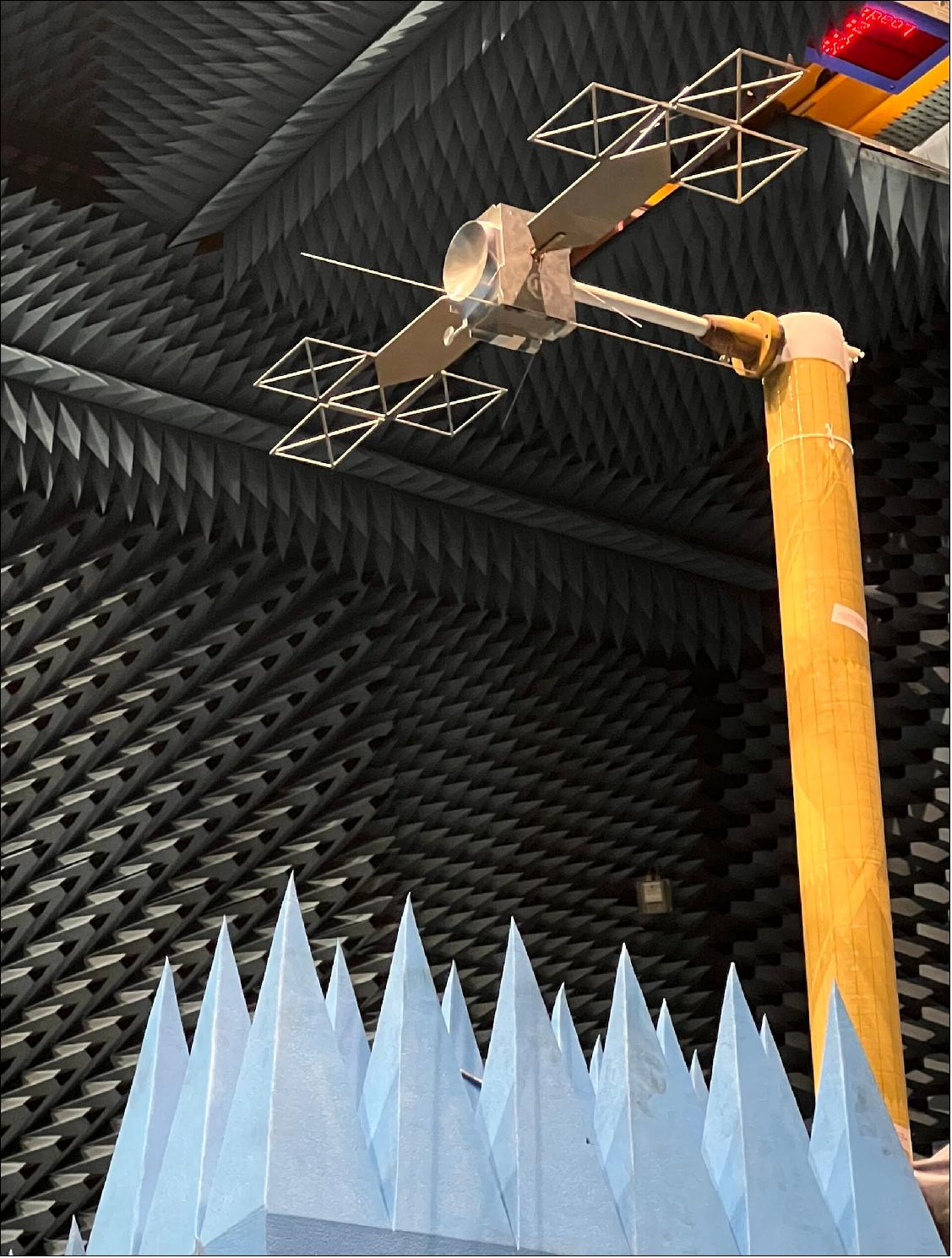
• July 29, 2021: ESA's Juice mission to Jupiter has successfully endured a month of space-like conditions inside the Large Space Simulator, the largest vacuum chamber in Europe. 17)
- At 10 m wide and 15 m high, the Large Space Simulator (LSS) is big enough to accommodate an upended London double decker bus. It is part of ESA's ESTEC Test Centre in the Netherlands, the largest satellite testing facility in Europe.
- The flight model of the Jupiter Icy Moons Explorer, Juice, was exposed to vacuum a billion times lower than standard seal level pressure, along with representative temperature extremes the spacecraft will encounter on its journey to Jupiter, ranging from 250°C to -180 °C.
- The LSS's artificial Sun simulator recreated the searing sunlight Juice will experience during its 88-month cruise phase, which will include a flyby of Venus. Liquid nitrogen circulating through the walls of the chamber mimicked the chill of deep space.
- After a month of round-the-clock monitoring, the chamber doors were opened on 15 July. Next the spacecraft will return to Airbus Defence and Space in France.
- Once in the Jovian system Juice will make detailed observations of Jupiter and its three large ocean-bearing moons – Ganymede, Callisto and Europa – with a suite of remote sensing, geophysical and in situ instruments.
- The mission will investigate the emergence of habitable worlds around gas giants and the Jupiter system as an archetype for the numerous giant exoplanets now known to orbit other stars.
• July 7, 2021: The ESA Jupiter Icy Moons Explorer (Juice) team has been working very hard to prepare the spacecraft for the first test in the one-year long environmental test campaign. This is the so-called Thermal Balance Thermal Vacuum (TBTV) test. 18)
- Juice is in the Large Space Simulator (LSS), a unique facility in Europe (run by the European Test Center, at ESA/ESTEC in the Netherlands) that can simulate the vacuum and cold and hot temperature conditions in space, and also the Sun itself!
- The TBTV started on 17 June with the closure of the LSS and the "pumping-down", meaning the removal of air within the chamber to a pressure level of 10nbar (1/100 000 000th of the outside air pressure). This is the closest Juice will come to space conditions while on Earth. It will undergo 24/7 testing, ending on 16 July 2021.
- In this episode this process is followed and several team members comment on the different moments.
• June 15, 2021: An instrument destined for Jupiter orbit undergoes eight days of cryogenic radio-frequency testing using a new test facility at ESA's ESTEC technical centre in the Netherlands. The SWI (Submillimeter Wave Instrument) of ESA's Juice mission will survey the churning atmosphere of Jupiter and the scanty atmospheres of its Galilean moons. 19)
• June 14, 2021: The Jupiter Icy Moons Explorer has moved into the ‘Large Space Simulator' at ESA's test centre, ready for grueling environmental tests at a range of temperatures. 20)
- Since arriving at ESA's European Space Research and Technology Centre (ESTEC) in April, a number of activities have taken place ahead of the environmental testing. This included the application of multi-layered insulation, a deployment test of the medium-gain antenna, and other preparatory activities – captured in the image gallery.
- Once the door of the Large Space Simulator (LSS) is sealed, Juice will spend several weeks being subjected to extreme heating and cooling cycles under vacuum, to confirm the spacecraft is ready for its long journey through the Solar System to Jupiter. Juice will experience highs of 250ºC close to Venus, and lows of around -180ºC in the Jovian system.
- The LSS is Europe's single largest vacuum chamber standing 15 m high and 10 m wide.
- Juice will remain at ESTEC until July, before being transported to Toulouse for its final round of tests. From there it will travel to Europe's Spaceport in French Guiana.
- Once in the Jovian system the mission will make detailed observations of the giant gas planet and its three large ocean-bearing moons – Ganymede, Callisto and Europa – with a suite of remote sensing, geophysical and in situ instruments. The mission will investigate the emergence of habitable worlds around gas giants and the Jupiter system as an archetype for the numerous giant exoplanets, now known to orbit other stars.
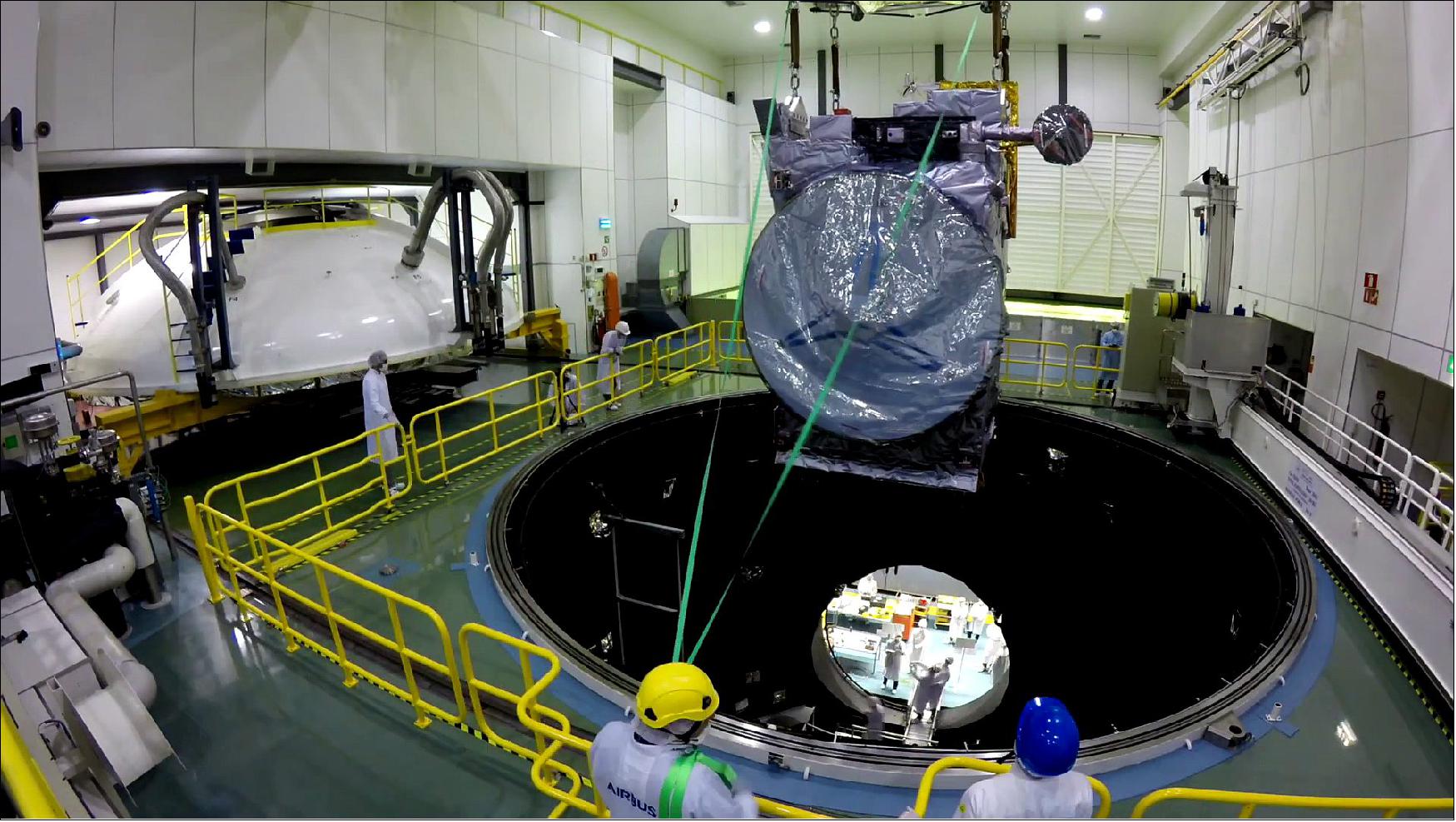
• May 27, 2021: An instrument destined for Jupiter orbit is checked after completing eight days of cryogenic radio-frequency testing at ESA's ESTEC technical centre in the Netherlands. 21)
- The SWI (Sub-millimeter Wave Instrument) model of ESA's Juice mission will survey the churning atmosphere of Jupiter and the scanty atmospheres of its Galilean moons.
- Testing took place in ESA's custom-built Lorentz (Low-temperature Near-field Terahertz chamber).
- The first chamber of its kind, the 2.8 m diameter Lorentz chamber can perform high-frequency radio-frequency testing in realistic space conditions, combining space-quality vacuum with ultra-low temperatures.
- "The successful test of the flight hardware inside Lorentz, follows an intensive commissioning phase." says ESA antenna engineer Paul Moseley. "This demonstration opens up a wide range of testing possibilities for missions to come."
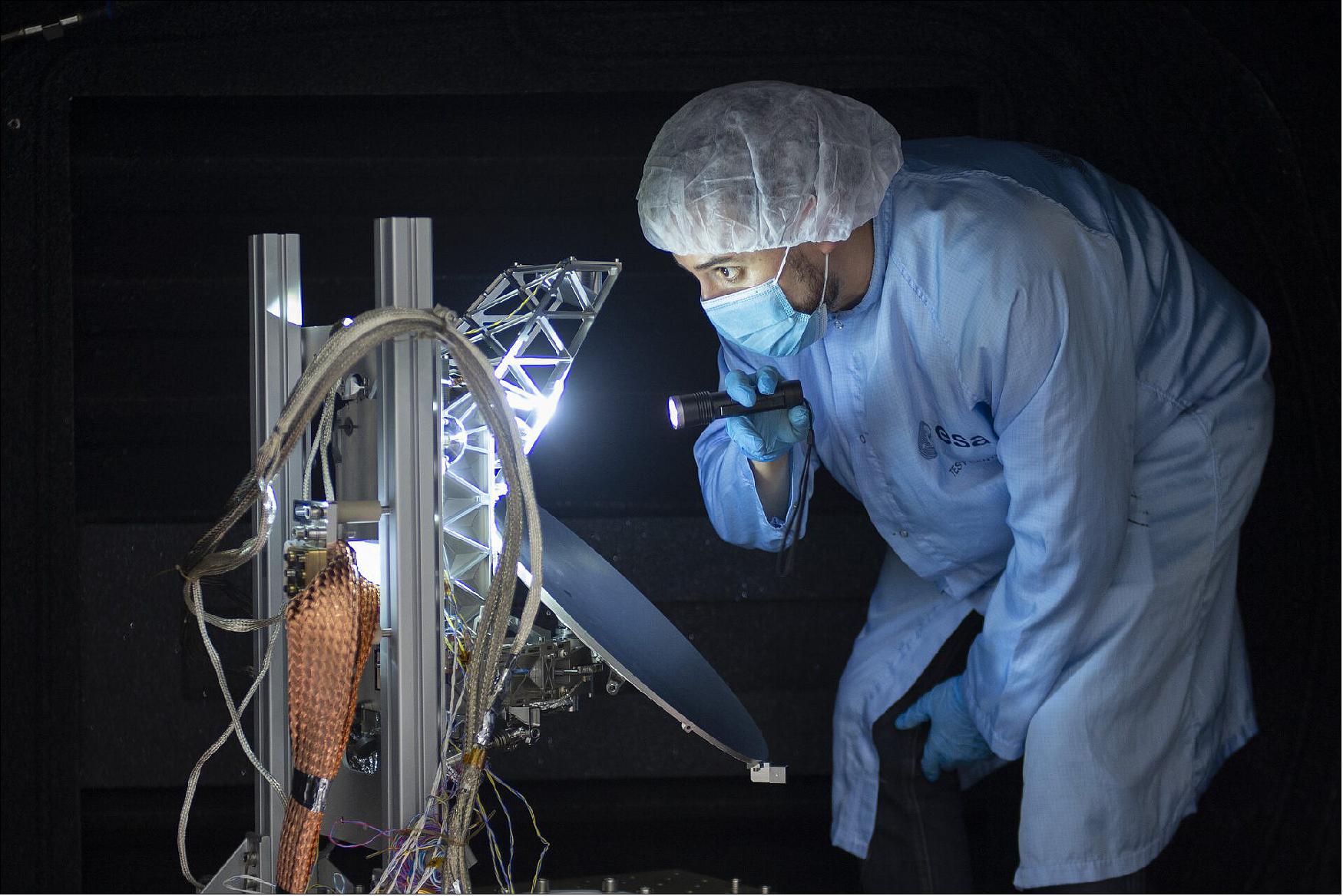
- Meanwhile the flight model of the SWI instrument's parent Juice spacecraft has itself reached the ESTEC Test Centre, in preparation for a month long thermal vacuum test campaign.
• May 10, 2021: ESA's JUICE spacecraft has been installed on a ‘multi-purpose trolley' in the Rosetta clean room at ESTEC (European Space Research and Technology Centre) in the Netherlands.
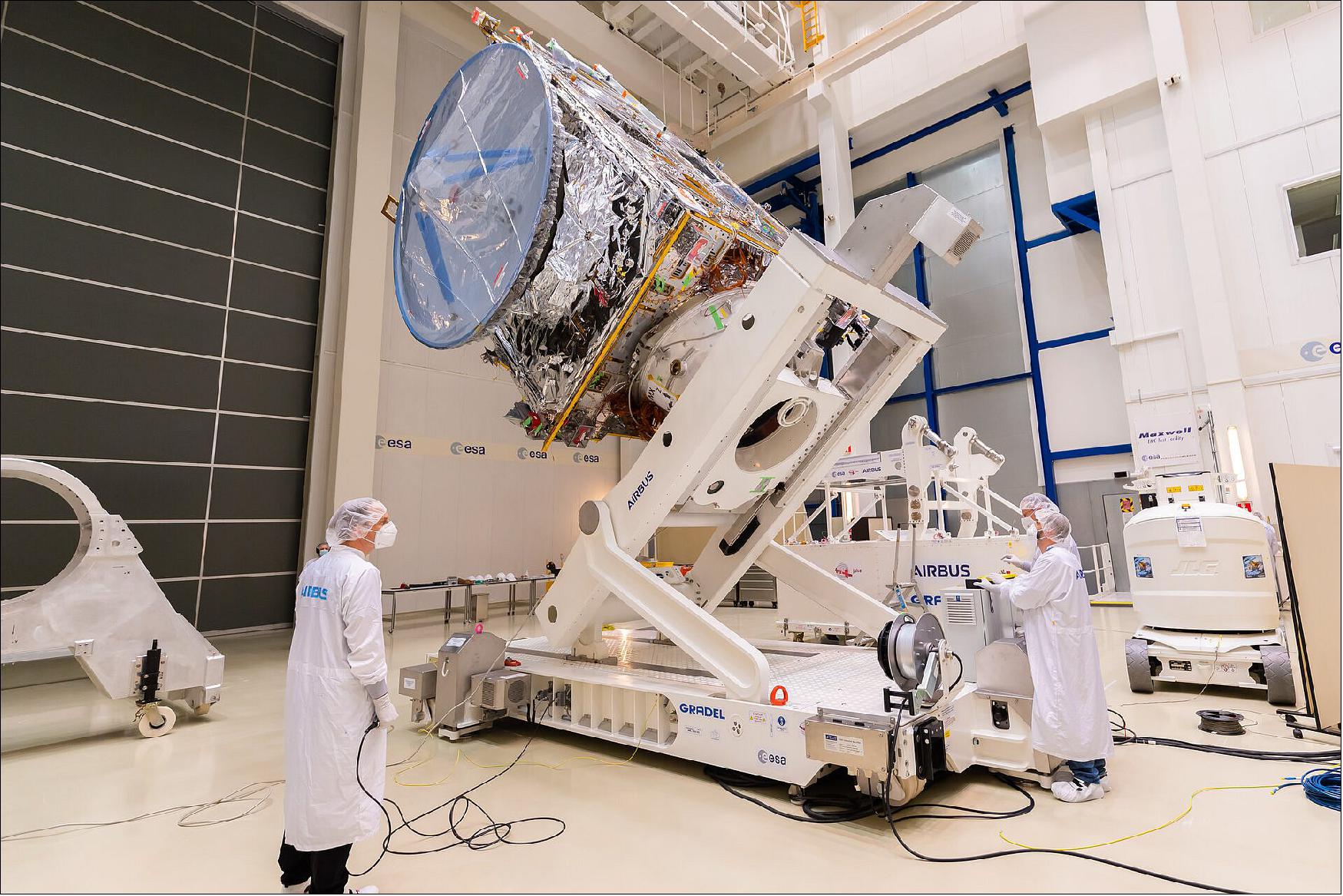
- Once in the Jovian system the mission will spend at least three years making detailed observations of the giant gaseous planet Jupiter and its three large ocean-bearing moons: Ganymede, Callisto and Europa.
• May 6, 2021: JUICE (Jupiter Icy Moons Explorer) has come ‘home' to ESA's technical centre in the Netherlands to undergo an extreme environment test in Europe's largest thermal vacuum chamber to prepare for its journey to the outer Solar System. 22)
- The spacecraft arrived at ESTEC, ESA's European Space Research and Technology Centre, from Airbus Friedrichshafen in Germany last week. It is now being unpacked and prepared to enter the ‘Large Space Simulator' later this month. It will spend several weeks being subjected to extreme heating and cooling cycles under vacuum, to confirm the spacecraft is ready for its long journey through the Solar System to Jupiter.
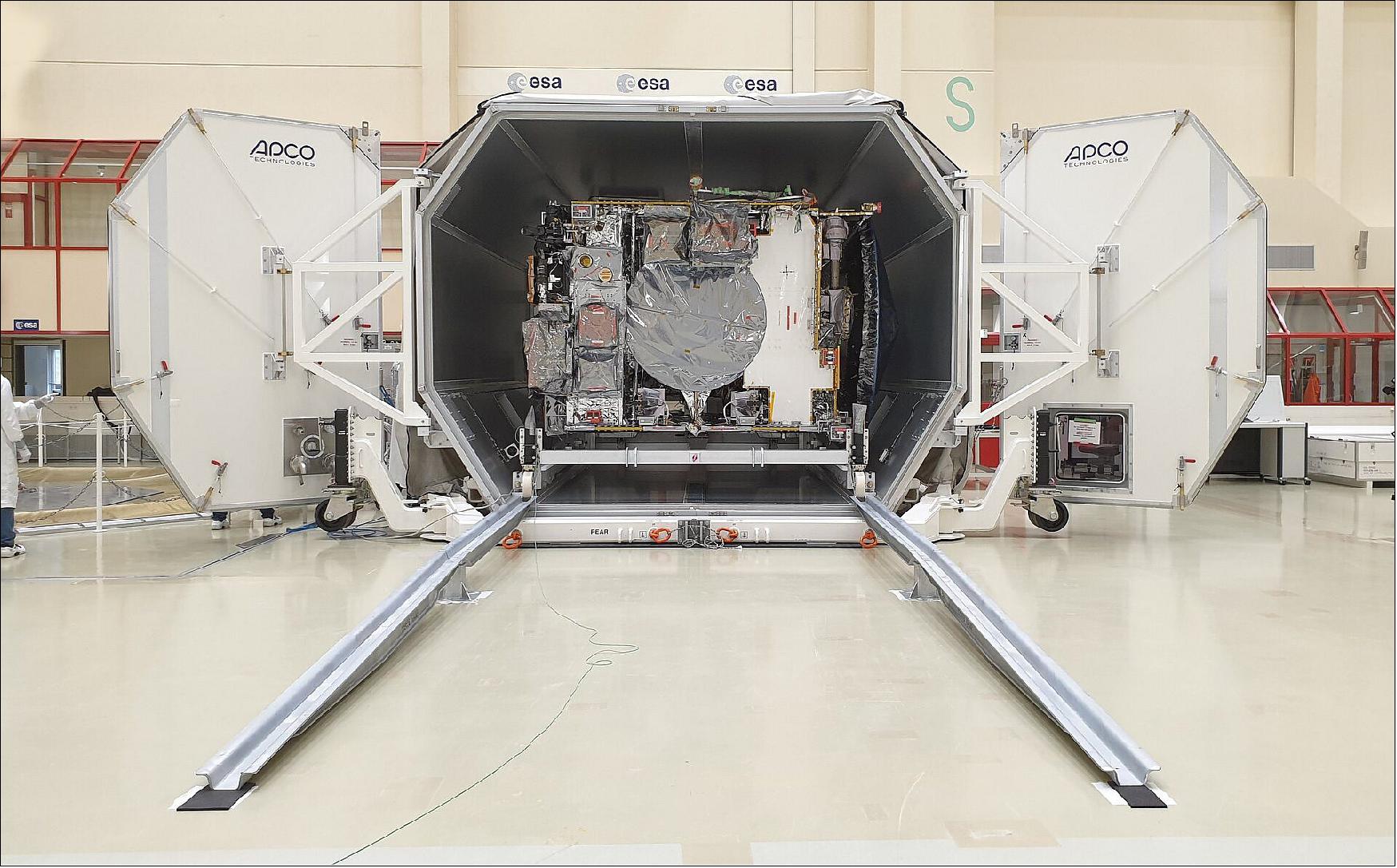
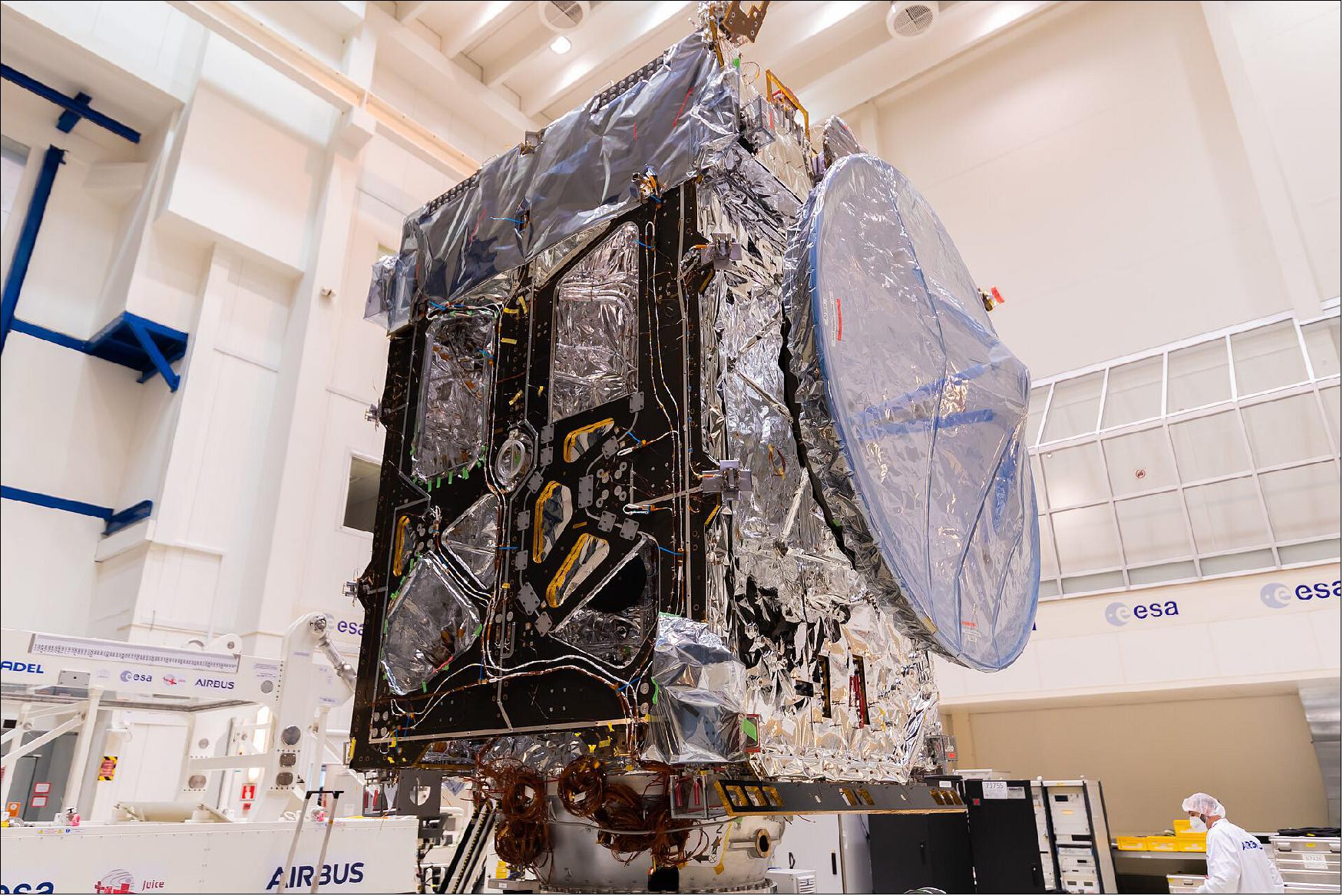
- Juice will remain at ESTEC until July, before being transported to Toulouse for its final round of tests. From there it will travel to Europe's Spaceport in French Guiana.
- Once in the Jovian system the mission will make detailed observations of the giant gas planet and its three large ocean-bearing moons – Ganymede, Callisto and Europa – with a suite of remote sensing, geophysical and in situ instruments. The mission will investigate the emergence of habitable worlds around gas giants and the Jupiter system as an archetype for the numerous giant exoplanets, now known to orbit other stars.
• February 8, 2021: ESA is preparing to launch an exciting space probe to the largest planet in our Solar System called the JUICE ( JUpiter ICy moons Explorer). To support teachers in using this out this world mission to run their STEM (Science Technology Engineering Mathematics) classes, ESA has prepared the Teach with Jupiter educational page, which hosts a variety of curricular STEM resources using Jupiter and the Solar System as the learning context. 23)
- Educators can use the Teach with Jupiter resources in and outside the classroom to engage primary and secondary students in STEM subjects by building on their natural curiosity for space and the exploration of the Solar System in particular.
- Teach with Jupiter compiles existing classroom resources on the Solar System, the orbits of planets, and extra-terrestrial life for primary and secondary levels, with more targeted resources to be added in the future. Teachers will also find a rich multimedia library on the topic of Jupiter and the Juice mission in particular, including a 3D rendering of the unique spacecraft.
- Among the activities recently launched is the Juice Up Your Rocket! Art competition that challenges kids up to 12 years old to help ESA create an illustration to decorate the huge Ariane 5 rocket that will launch the spacecraft on its long journey towards planet Jupiter. The competition will be open until 1 June 2021, 23:59 (CEST). Join now with your students! Find more information on Jupiter and Juice mission for younger primary learners on the ESA Kids website.
- This page will be frequently updated, so stay tuned for new resources.
• October 16, 2020: All ten solar panels for ESA's Jupiter Icy Moons Explorer, JUICE, have arrived at Airbus Defence and Space in The Netherlands ready to be turned into the spacecraft's two solar wings. The solar panels are a key element of the mission, providing the necessary power to run the spacecraft and operate the science instruments. 24)
- En route to Jupiter, JUICE will make several gravity assist flybys at Earth, Venus and Mars before heading to the outer Solar System, meaning that the solar panels have to withstand a large temperature range from +110ºC to -230ºC. At Jupiter, there will be times when the spacecraft is temporarily eclipsed by the giant planet and the moons, depriving it from any sunlight, leading to a rapid cool down of the solar arrays. In addition, the spacecraft will be subjected to a harsh radiation environment. Extensive testing is carried out to ensure the spacecraft and its solar arrays can survive these tough conditions.
- The next step for the solar panels is to turn them into wings and to test the deployment mechanisms. Further checks will also be made to verify that the spacecraft and its instruments can receive all of the power generated by the solar array even under the most challenging conditions.
- JUICE will investigate Jupiter and three of its planet-sized moons – Ganymede, Europa and Callisto – which are thought to have oceans of liquid water beneath their icy crusts. This makes them extremely interesting to study to better understand the habitability potential of ocean worlds – in our own Solar System and in exoplanet systems beyond.

• September 21, 2020: Engineers at NASA's Jet Propulsion Laboratory met a significant milestone recently by delivering key elements of an ice-penetrating radar instrument for an ESA (European Space Agency) mission to explore Jupiter and its three large icy moons. 25)
- Part of the RIME (Radar for Icy Moon Exploration) instrument, the transmitter sends out radio waves, which can penetrate surfaces of icy moons and help scientists "see" underneath. A collaboration between JPL and the Italian Space Agency (ASI), RIME is one of the JUICE instruments.
- Despite COVID-19-related hurdles, crucial NASA instrument components for the European-led JUICE spacecraft have been delivered. Engineers at NASA/JPL met a significant milestone recently by delivering key elements of an ice-penetrating radar instrument, RIME (Radar for Icy Moons Exploration), for an ESA mission to explore Jupiter and its three large icy moons.
- While following the laboratory's stringent COVID-19 Safe-at-Work precautions, JPL teams managed to build and ship the receiver, transmitter, and electronics necessary to complete the radar instrument for the JUICE mission.
- RIME is key to exploring those moons. It sends out radio waves that can penetrate the surface up to 10 km and collects data on how the waves bounce back. Some of the waves penetrate the crust and reflect off subsurface features - and the watery interiors - enabling scientists to "see" underneath.
- In the case of Europa, which is believed to have a global ocean beneath its crust, the radar data will help gauge the thickness of the ice. NASA's Europa Clipper mission, set to launch in the mid-2020s, will arrive around the same time as JUICE and collect complementary science as it performs multiple flybys of Europa.
- A collaboration between NASA/JPL in Pasadena and the Italian Space Agency (ASI), JUICE's RIME is led by Principal Investigator Lorenzo Bruzzone of the University of Trento in Italy. JPL's responsibility was to make and deliver the transmitter and receiver - the pieces that send out and pull in radio signals - as well as the electronics that help those pieces communicate with RIME's antenna. Now that the components have been delivered to ASI in Rome, the next steps are to test and integrate them before assembling the instrument.
- "I'm really impressed that the engineers working on this project were able to pull this off," said JPL's Jeffrey Plaut, co-principal investigator of RIME. "We are so proud of them, because it was incredibly challenging. We had a commitment to our partners overseas, and we met that - which is very gratifying."
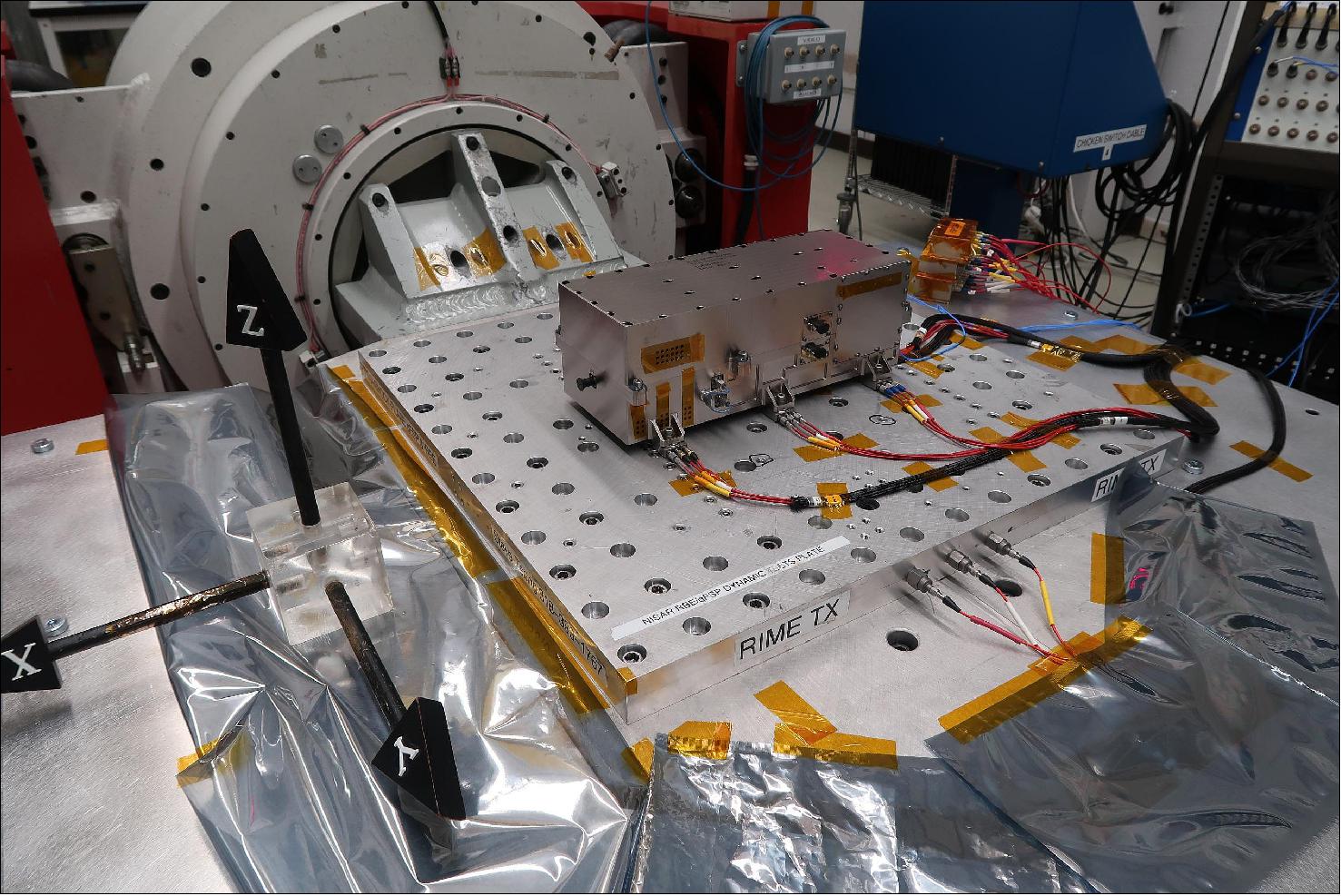
• June 26, 2020: Despite certain operational difficulties caused by the COVID-19 pandemic, the assembly and integration of the flight model for ESA's JUICE (JUpiter ICy moons Explorer) spacecraft has continued with few delays during the first six months of the year. 26)
• April 23, 2020: ESA's upcoming JUICE spacecraft arrives at the satellite integration center of the project's prime contractor Airbus in Friedrichshafen, Germany, in April 2020, to undergo final integration. 27)
- Expected to set out for its seven-year cruise to Jupiter in 2022, JUICE will carry 10 scientific instruments for detailed inspection of the largest planet of the Solar System and its moons, including Ganymede, Europa and Callisto, which are believed to host oceans of water. During its planned three-year mission, the spacecraft is expected to answer the question whether the oceans of the icy moons host any forms of life.
- A result of cooperation of more than 80 companies from all over Europe, JUICE was built and assembled in Airbus' facilities in Madrid. The spacecraft was then fitted with a propulsion system at ArianeGroup's site in Lampoldshausen, Germany, to form the spacecraft body, and transported to Friedrichshafen inside a special secured container on board of an oversized transporter.
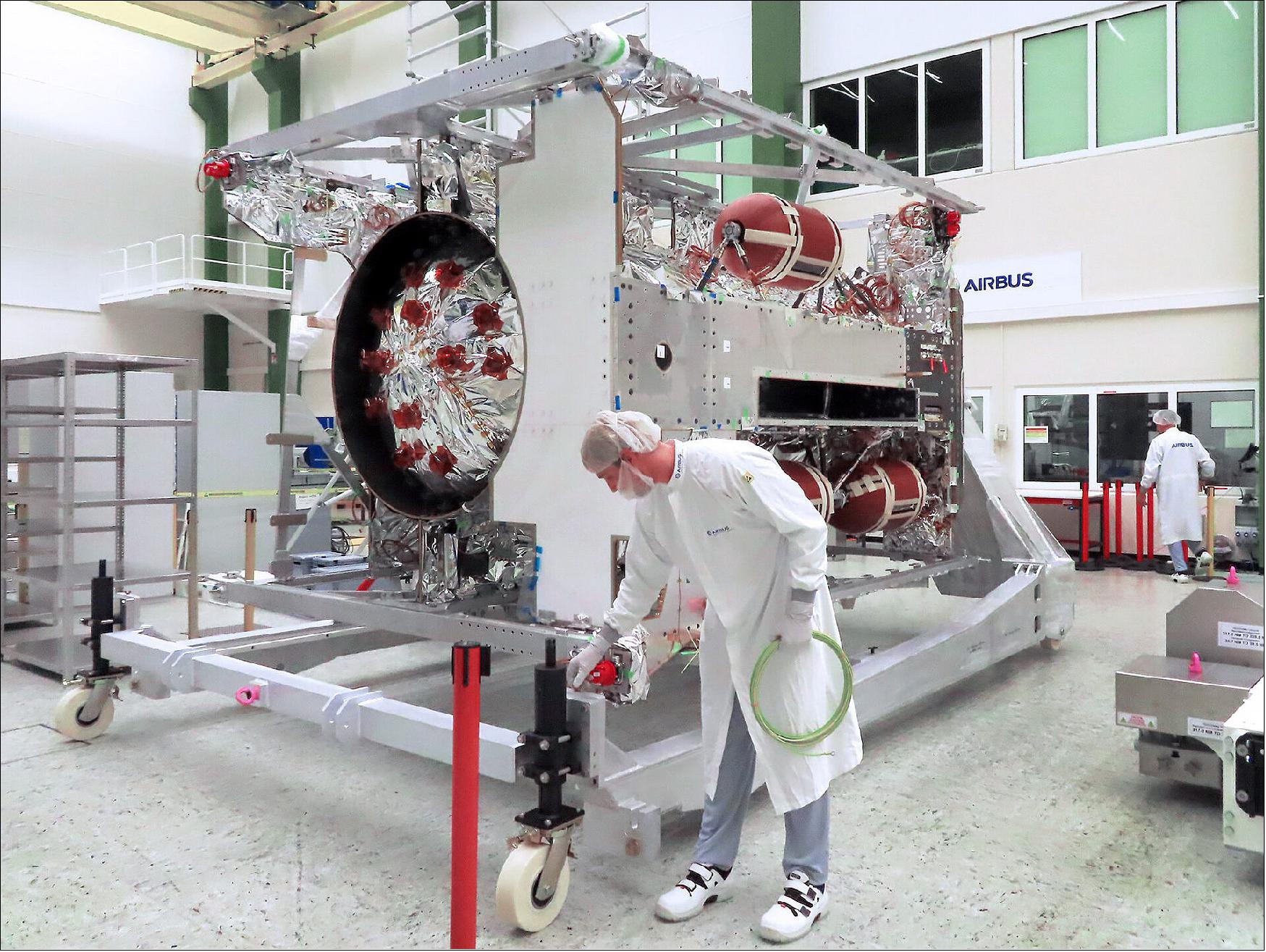
• February 25, 2020: The first instrument to fly on ESA's JUICE ( Jupiter Icy Moon Explorer) has been delivered for integration onto the spacecraft this month. The UVS (Ultraviolet Spectrograph), pictured in this photo while being prepared before shipping, was designed and built by Southwest Research Institute in San Antonio, TX, US. 28)
- Juice is the first large-class mission in ESA's Cosmic Vision 2015–2025 program. JUICE will perform detailed observations of the giant planet and three of its largest moons: Ganymede, Callisto and Europa.
- The mission, which is being developed by Airbus Defence and Space as prime contractor, comprises 10 state-of-the-art instruments to investigate the Jupiter system plus one experiment that uses the spacecraft telecommunication system jointly with ground-based radio observations (Very Long Baseline Interferometry). The 10 instruments will perform in situ measurements of Jupiter's atmosphere and plasma environment as well as remote observations of the surface and interior of the three icy moons.
- As part of Juice's comprehensive suite of instruments, UVS will get close-up views of Europa, Ganymede and Callisto, which are all thought to host underground oceans beneath their icy surfaces. By recording the ultraviolet light emitted, transmitted and reflected by the moons, the instrument will reveal the composition of their surfaces and atmospheres, and enable investigations of how these icy bodies interact with Jupiter and its giant magnetosphere.
- UVS will cover the wavelength range between 55 and 210 nm with spectral resolution better than 0.6 nm. It will achieve a spatial resolution of 0.5 km at Ganymede and up to 250 km at Jupiter.
- The instrument is now at the premises of Airbus Defence & Space GmbH in Friedrichshafen, Germany, where it will be integrated on the spacecraft. The other nine instruments are being integrated and tested by the respective instrument teams and will be delivered for integration over the course of 2020.
- The UVS instrument represents NASA's contribution to the mission. The instrument team, led by scientists at Southwest Research Institute, includes additional scientists from University of Colorado Boulder and SETI institute in the US, as well as University of Leicester and Imperial College London (UK), University of Liège (Belgium) and Laboratoire Atmosphères, Milieux, Observations Spatiales (France). NASA's New Frontiers Program at Marshall Space Flight Center (MSFC) oversees the UVS contribution to ESA.
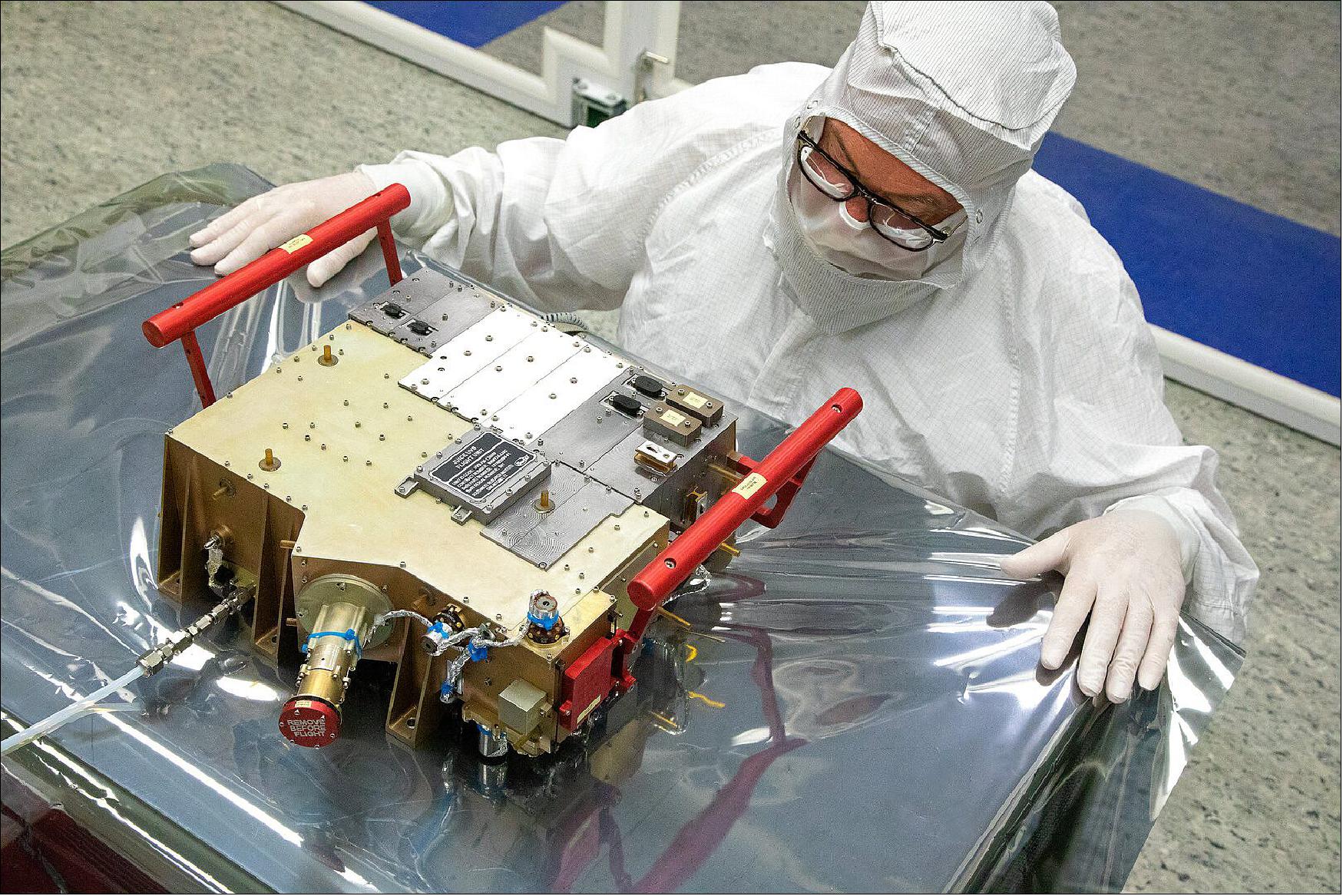
• November 19, 2019: For the solar array of ESA's JUICE mission to Jupiter, Airborne delivered the last 4 out of 10 XL substrate panels to Airbus Defence and Space Netherlands. As timing is critical for the interplanetary spacecraft to be put on the right trajectory enabling gravity-assist flybys, the delivery of the XL panels is crucial in order for the solar array to be readied according to schedule. Given extreme distance from the Sun, the JUICE spacecraft asked for an exceptionally large solar array in order to generate sufficient power. 29)
- As market leader in the manufacturing of solar array substrate panels in Europe, Airborne was selected by Airbus Defence and Space Netherlands to develop and manufacture the XL substrate panels for JUICE's solar array. With a total surface area of 85 m2 the satellite will be equipped with the largest solar array ever flown on an interplanetary mission.
- Airborne's specific expertise was required to produce the substrate panels for the solar panels with a surface area of almost 9 m2 per panel - the largest units manufactured by Airborne to date. To enable production Airborne modified the manufacturing equipment, including extending the maximum inside diameter of the autoclave from 2.6 to 2.9 meters. Combined with a length of 13 meters, the extended autoclave enables Airborne to produce more XL size panels for aerospace customers.
- JUICE's solar array is built with the new ARA (Advanced Rigid Array) Mk4 technology, which has been developed and qualified by Airbus Defence and Space Netherlands in close cooperation with Airborne. Airbus' ARA Mk4 technology allows for 20 percent cost reduction and increases the robustness of the solar array by expanding the temperature range and adding stiffness. As the satellite will be exposed to extreme conditions during the full length of the mission, the panels need to withstand temperatures as low as -240º Celsius, as well as space radiation.
- The extreme temperatures to which the satellite will be exposed near Jupiter made additional qualification necessary on the panel design and its interfaces. Airborne manufactured 160 qualification test samples and two full-size panels which were delivered in January 2017. After an intensive testing campaign by Airbus Defence and Space Netherland, Airborne manufactured a total of 10 substrate panels. The last 4 panels were completed in October 2019 - on time for the next step in the manufacturing process of JUICE's solar array.
- Arno van Mourik, CEO of Airborne says: "JUICE is a great example of what we can do in terms of state-of-the-art substrate panel technology for solar arrays of extremely demanding space missions. Building on this position we are determined to move forward in the domain of affordable space panels for new space. Combining our knowledge on high end substrates with our capabilities in the domain of industrialization of composites will allow us to provide the new space market with high performance, yet radically affordable solutions in high volumes."
- ESA selected Airbus as prime contractor for the design, development, production, and testing of spacecraft JUICE.
• November 4, 2019: In a decade's time, an exciting new visitor will enter the Jovian system: ESA's JUICE (Jupiter Icy Moons Explorer) mission. As its name suggests, the mission will explore Jupiter and three of its largest moons – Ganymede, Callisto and Europa – to investigate the giant planet's cosmic family and gas giant planets in general. 30)
- JUICE instruments are currently being perfected and calibrated so they are ready to start work once in space. This image shows one of the many elements involved in this calibration process: a miniature gold-plated metallic model of JUICE used to test the spacecraft's antennas.
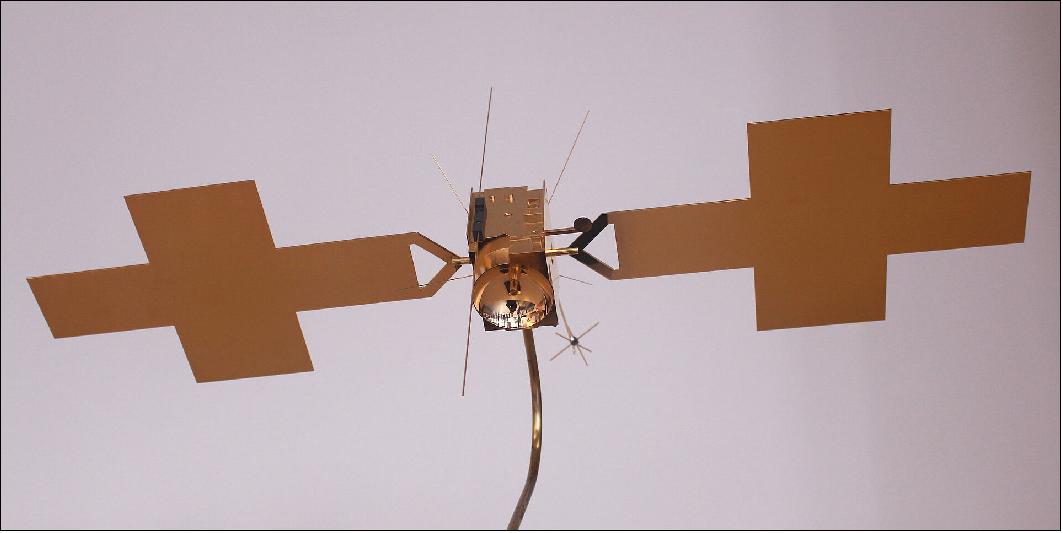
- JUICE will carry multiple antennas to detect radio waves in the Jupiter system. These antennas will measure the characteristics of the incoming waves, including the direction in which they are moving and their degree of polarization, and then use this information to trace the waves back to their sources. In order to do this, the antennas must work well regardless of their orientation to any incoming waves – and so scientists must figure out and correct for the antennas' so-called ‘directional dependence'.
- This shiny model was used to perform a set of tests on JUICE's Radio and Plasma Wave Instrument (RPWI) last year. It was submerged in a tank filled with water; an even electric field was then applied to the tank, and the model was moved and rotated with respect to this field. The results revealed how the antennas will receive radio waves that stream in from different directions and orientations with respect to the spacecraft, and will enable the instrument to be calibrated to be as effective as possible in its measurements of Jupiter and its moons.
- Similar tests, which are technically referred to as rheometry, were conducted in the past for spacecraft including the NASA/ESA/ASI Cassini-Huygens mission to Saturn (which operated at Saturn between 2004 and 2017), NASA's Juno spacecraft (currently in orbit around Jupiter), and ESA's Solar Orbiter .
- The test performed for Juice posed a few additional hurdles – the model's antennas were especially small and needed to be fixed accurately onto the model's boom, which required scientists to create a special device to adjust not only the antennas, but also the boom itself.
- The model was produced at a 1:40 scale, making each antenna 62.5 mm long from tip to tip; scaled up, the antennas will be 2.5 m long on JUICE. The main spacecraft parts modelled here include the body of the probe itself, its solar panels, and its antennas and booms. The model has an overall ‘wingspan' of 75 cm across its solar panels. The photo also shows a spacecraft stand, which extends out of the bottom of the frame. The gold coating ensured that the model had excellent electric conducting properties, and reacted minimally with the surrounding water and air during the measurements.
- Meanwhile, the assembly of the JUICE flight model has started in September, with the delivery of the spacecraft's primary structure, followed by integration of the propulsion system.
• October 23, 2019: The assembly of the flight model of ESA's JUICE spacecraft began in September, with the delivery of the spacecraft's primary structure, followed by integration of the propulsion system that will enable the mission to reach and study Jupiter and its moons. 31)
- The primary structure of the spacecraft features a central tube – the main load bearing element – with vertical shear panels located radially around the tube, and horizontal floor panels. This will be completed later with the optical bench and external closing panels that will form the outer walls and will be added when all the internal equipment has been integrated.
- The structure is part of the SSTS ( Structure, Shielding and Thermal Subsystem), built under the responsibility of Airbus Defence & Space in Madrid, Spain, with participation by RUAG Space Switzerland and RUAG Space Austria.
- One of the features of the JUICE SSTS is that the some of the vertical panels and parts of the closing walls of the structure are lined with a thin layer of lead, which provides shielding to protect the spacecraft's electronic systems from damage by the severe radiation environment at Jupiter.
- One of the features of the JUICE SSTS is that the some of the vertical panels and parts of the closing walls of the structure are lined with a thin layer of lead, which provides shielding to protect the spacecraft's electronic systems from damage by the severe radiation environment at Jupiter.
- Over the coming months, five companies will be working almost simultaneously on the SSTS in order to ensure that JUICE can proceed to the assembly and integration phase that will take place in Airbus facilities in Friedrichshafen, Germany.
- One of the main tasks at Lampoldshausen will be to integrate the propulsion system. This includes two identical propellant tanks that have been newly developed for EuroStar Neo, ESA's new generation of platforms for geostationary telecommunications satellites. JUICE will be the first space mission to actually utilize them.
- The first titanium tank, capable of holding 1600 liters of oxidant (mixed oxides of nitrogen, or MON), was carefully lowered inside the spacecraft's central cylinder on 7 September. The second tank, which will contain monomethyl hydrazine (MMH) fuel, is scheduled for installation at the end of October.
- "JUICE will need to carry more than 3000 kg of propellant in these tanks," said Daniel Escolar, ESA's Mechanical, Thermal & Propulsion System Engineer for the mission. "Such a large load will be essential for JUICE to arrive in orbit around Jupiter and complete its scientific tour with multiple flybys of the Galilean moons, before eventually becoming the first spacecraft ever to enter orbit around Ganymede."
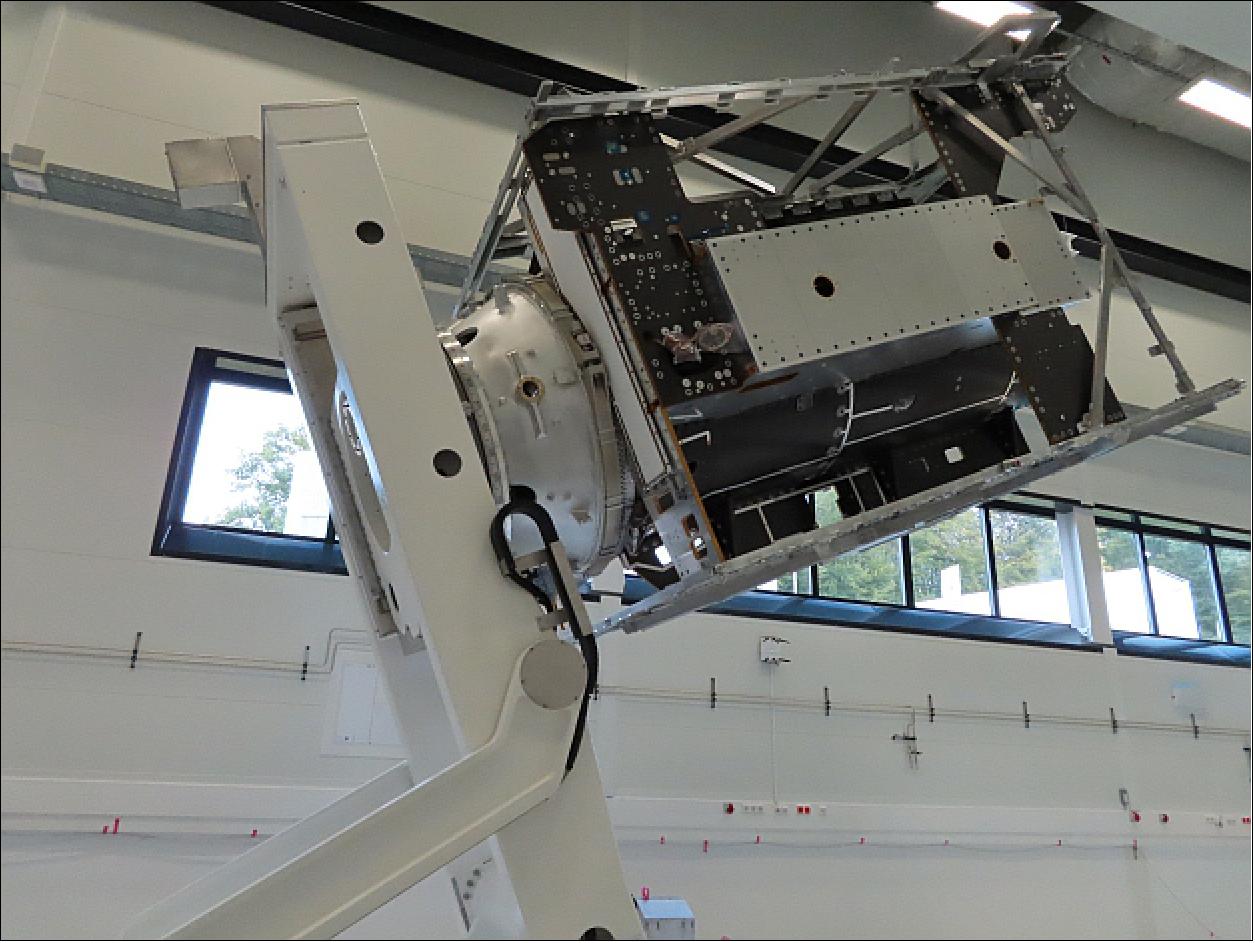
- The integration of the spacecraft's propulsion system will, however, involve much more than installing two propellant tanks. Eventually, three fairly small tanks, each filled with helium pressurant, will be affixed around the exterior of the central cylinder, together with all the necessary plumbing. Some 130 meters of titanium piping will also have to be installed and welded in the SSTS.
- Other hardware to be added during installation of the propulsion system will include pressure regulators, valves, filters and thrusters. In addition to its single 400-newton main engine that will be used for the larger orbital maneuvers, JUICE will carry eight 22-newton thrusters for smaller maneuvers and as a backup system, along with twelve 10-newton thrusters for attitude control.
- Meanwhile, engineers are busy carrying out other essential tasks that can only be completed whilst the external panels are not fitted, enabling easy access to the spacecraft's interior. These include placing single layer insulation around the central cylinder, adding thermocouples to measure temperatures, and attaching support fixtures for the harness that will eventually be required to carry around 10 km of electrical cable.
- According to the current schedule, the JUICE flight model will be moved to Friedrichshafen around March next year for integration and testing of its electrical systems.
- In the meantime, development of the JUICE scientific payload is continuing, and the magnetometer boom for the flight model has recently been delivered to ESA/ESTEC (Space Research and Technology Center) in Noordwijk, the Netherlands, for three weeks of vibration and deployment tests.
• August 28, 2019: The test facility at CERN, the European Organization for Nuclear Research, was used to simulate the high-radiation environment surrounding Jupiter to prepare for ESA's JUICE mission to the largest planet in our Solar System. 32)
- All candidate hardware to be flown in space first needs to be tested against radiation: space is riddled with charged particles from the Sun and further out in the cosmos. An agreement with CERN gives access to the most intense beam radiation beams available – short of travelling into orbit.
- Initial testing of candidate components for ESA's JUpiter ICy moons Explorer, JUICE, took place last year using CERN's VESPER (Very energetic Electron facility for Space Planetary Exploration missions in harsh Radiative environments) facility.
- VESPER's high energy electron beamline simulated conditions within Jupiter's massive magnetic field, which has a million times greater volume than Earth's own magnetosphere, trapping highly energetic charged particles within it to form intense radiation belts.
- JUICE needs to endure this harsh radiation environment in order to explore Callisto, Europa and Ganymede – moons of Jupiter theorized to hide liquid water oceans beneath their icy surfaces. JUICE is being built by Airbus for ESA, with construction of its spacecraft flight model due to begin next month.
- Last month ESA and CERN signed a new implementing protocol, building upon their existing cooperation ties.
- Signed by Franco Ongaro, ESA's Director of Technology, Engineering and Quality, and Eckhard Elsen, CERN Director for Research and Computing, this new agreement identifies seven specific high-priority projects: high-energy electron tests; high-penetration heavy-ion tests; assessment of commercial off-the-shelf components and modules; in-orbit technology demonstration; ‘radiation-hard' and ‘radiation-tolerant' components and modules; radiation detectors monitors; and dosimeters and simulation tools for radiation effects.
- "The radiation environment that CERN is working with within its tunnels and experimental areas is very close to what we have in space," explains Véronique Ferlet-Cavrois, Head of ESA's Power Systems, EMC & Space Environment Division.
- "The underlying physics of the interaction between particles and components is the same, so it makes sense to share knowledge of components, design rules and simulation tools. Plus access to CERN facilities allows us to simulate the kind of high-energy electrons and cosmic rays found in space. At the same time we are collaborating on flying CERN-developed components for testing in space."
- Petteri Nieminen, heading ESA's Space Environments and Effects section adds: "Along with JUICE, CERN heavy-energy radiation testing will also be useful for our proposed Ice Giants mission to Neptune and Uranus. The spacecraft may have to be pass through Jupiter's vast magnetic field on the way to these outer planets, and both worlds have radiation belts of their own.
- "And the ability to simulate cosmic rays benefits a huge number of missions, especially those venturing beyond Earth orbit, including Athena and LISA as well as JUICE. It is also a huge interest for human spaceflight and exploration to study radiobiology effects of heavy ion cosmic rays on astronaut DNA. Not to mention that radiation simulations developed in collaboration with CERN help set space environment specifications for all ESA missions."
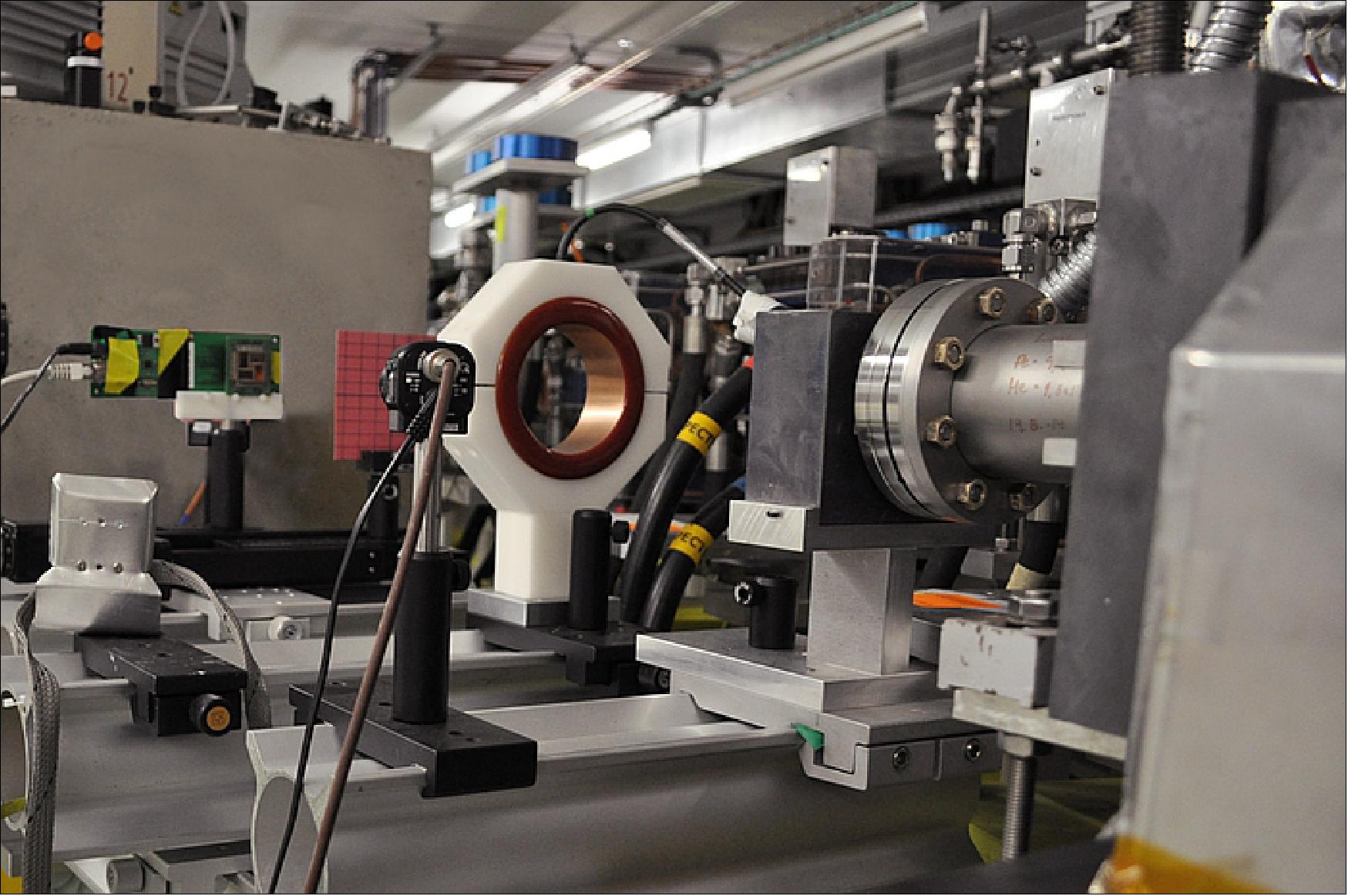
• August 22, 2019: As part of preparations for the launch of ESA's Jupiter Icy Moons Explorer, its navigation camera has been given a unique test: imaging its destination from Earth. 33)
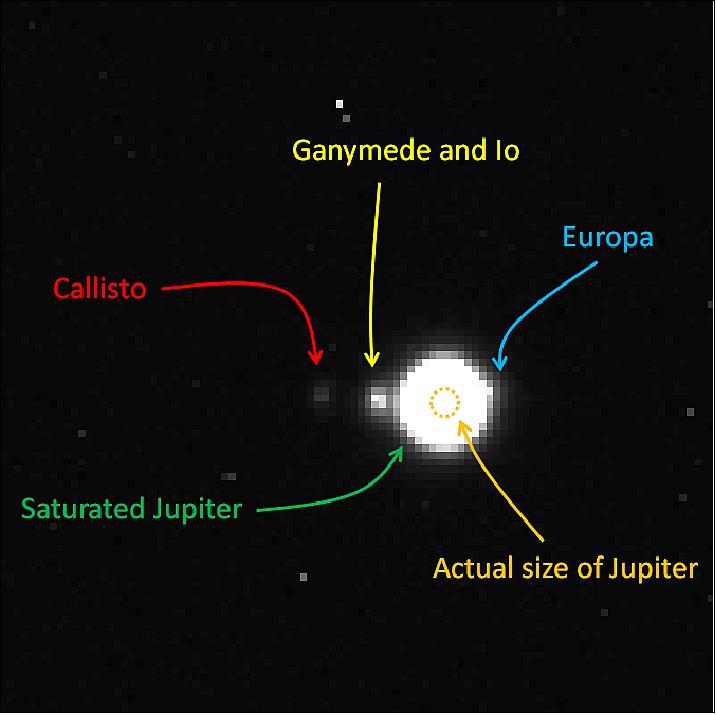
- The NavCam has been specifically designed to be resistant to the harsh radiations environment around Jupiter and to acquire images of the planet, moon and background stars. Importantly, NavCam measurements will allow the spacecraft to be in the optimal trajectory and to consume as little fuel as possible during the grand tour of Jupiter, and to improve the pointing accuracy during these fast and close rendezvous approaches. The close encounters will bring the spacecraft between about 200 and 400 km to the moons.
- In June, a team of engineers took to the roof of the Airbus Defence and Space site in Toulouse to test the NavCam engineering model in real sky conditions. The purpose was to validate hardware and software interfaces, and to prepare the image processing and onboard navigation software that will be used in-flight to acquire images.
- In addition to observing Earth's Moon and other objects, the instrument was pointed towards an obvious target in the night sky: Jupiter. The camera used the ‘Imaging mode' and ‘Stars Centroiding Mode' to test parameter settings which in turn will be used to fine-tune the image processing software at attitude control and navigation levels.
- "Unsurprisingly, some 640 million km away, the moons of Jupiter are seen only as a mere pixel or two, and Jupiter itself appears saturated in the long exposure images needed to capture both the moons and background stars, but these images are useful to fine-tune our image processing software that will run autonomously onboard the spacecraft," says Gregory Jonniaux, Vision-Based Navigation expert at Airbus Defence and Space. "It felt particularly meaningful to conduct our tests already on our destination!"
- During the flybys themselves it will be possible to see surface features on these very different moons. In a separate test, the NavCam was optically fed with simulated views of the moons to process more realistic images of what can be expected once in the Jupiter system.

- Meanwhile the test navigation camera will be further improved with a full flight representative performance optics assembly by the end of the year, and will subsequently be used to support onboard software tests of the complete JUICE spacecraft. After launch, the test camera will be used at ESA's operations center to support the mission operations throughout its mission.
• June 17, 2019: JUICE, will ride into space on an Ariane launch vehicle, Arianespace and ESA confirmed today at the International Paris Air Show. 34)
- JUICE is the first large-class mission in ESA's Cosmic Vision 2015–2025 program. Its mission is devoted to complete a unique tour of the Jupiter system.
- JUICE will spend at least three years making detailed observations of the giant gaseous planet Jupiter and in-depth studies of three of its largest moons and potentially ocean-bearing satellites, Ganymede, Europa and Callisto.
• April 3, 2019: ESA's JUpiter ICy moons Explorer, JUICE, has been given the green light for full development after its CDR (Critical Design Review) was successfully concluded on 4 March. This major milestone marks the beginning of the qualification and production phase, taking this flagship mission one key step closer to starting its long journey to Jupiter in 2022. 35)
• March 20, 2019: A test version of the 10.5 m long magnetometer boom built for ESA's mission to Jupiter, developed by SENER in Spain, seen being tested at ESA's Test Center in the Netherlands, its mass borne by balloons. 36)
- The flight model will be mounted on the JUICE (Jupiter Icy Moons Explorer) spacecraft.
- The Juice spacecraft will carry the most powerful remote sensing, geophysical, and in situ payload complement ever flown to the outer Solar System. Its payload consists of 10 state-of-the-art instruments.
- This includes a magnetometer instrument that the boom will project clear of the main body of the spacecraft, allowing it to make measurements clear of any magnetic interference. Its goal is to measure Jupiter's magnetic field, its interaction with the internal magnetic field of Ganymede, and to study subsurface oceans of the icy moons.
- The deployment of this qualification model boom has been performed before and after simulated launch vibration on the Test Center shaker tables to ensure it will deploy correctly in space. Since the boom will deploy in weightlessness, three helium balloons were used to help bear its weight in terrestrial gravity.
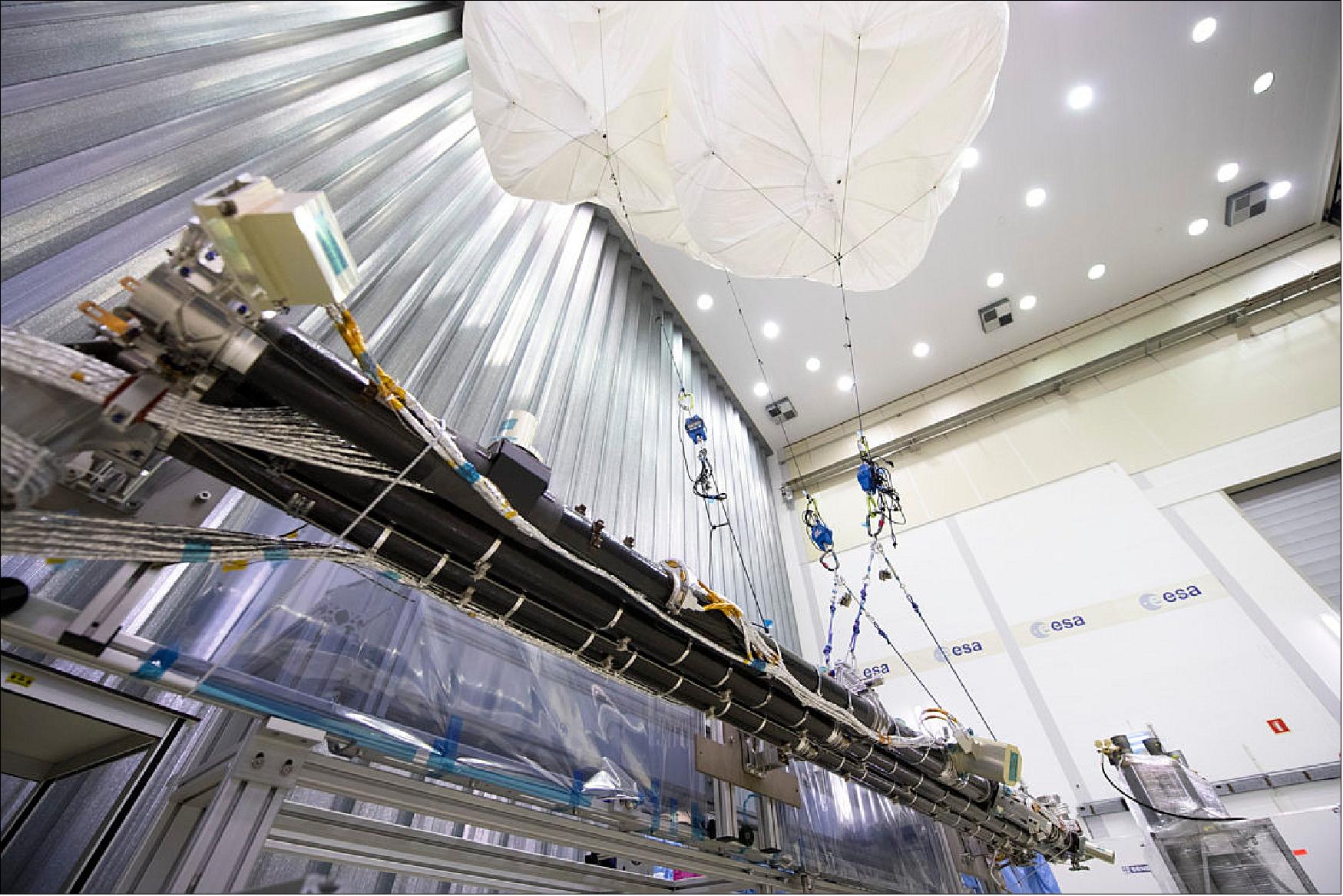
• December 11, 2018: The JUICE engineering model spacecraft test readiness review was completed successfully on 2 October, and the first engineering model instruments are now being delivered and tested. 37)
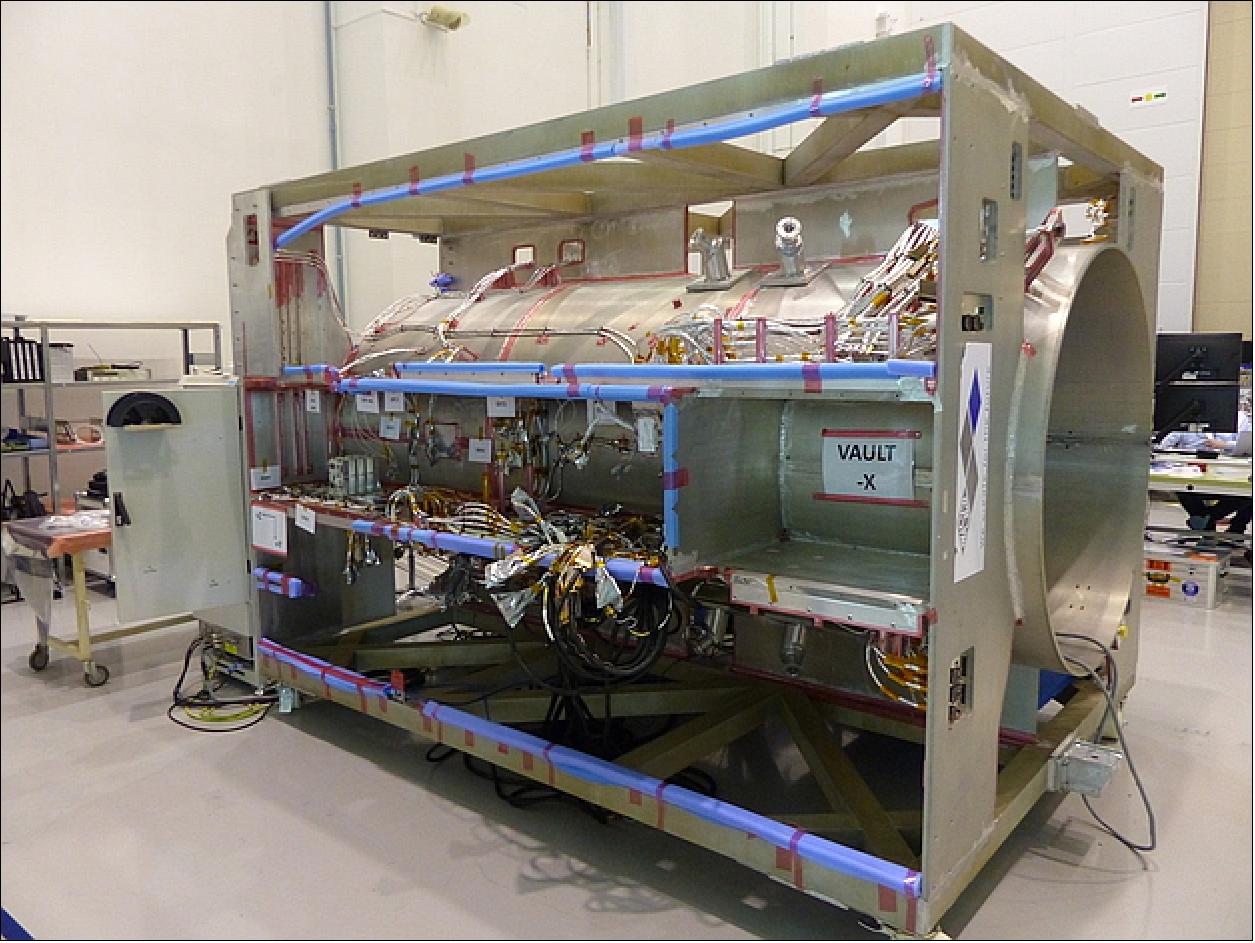
- A major step in the development of ESA's upcoming JUICE mission to the Jupiter system is the start of integration and testing of the spacecraft engineering model at the facilities of prime contractor Airbus Defence and Space in Toulouse, France.
- Following the JUICE flight model spacecraft test readiness review, in October 2019, the engineering model will be used to test procedures and study functional issues that may arise during the development testing of the flight model. The engineering model will also be used, on ground, in support of the actual spacecraft operations after launch.
• November 12, 2018: JUICE is ESA's future mission to explore the most massive planet in Solar System and its large moons Ganymede, Europa and Callisto. It will embark on a seven-year cruise that will make use of several flybys – of Earth, Venus, Earth, Mars, and Earth again – before leaving the inner Solar System en route to Jupiter. 38)
- All three moons are thought to have oceans of liquid water beneath their icy crusts, and the Radar for Icy Moons Exploration (RIME) instrument on Juice will be used to probe their subsurface structure. Emitted by a 16-m long antenna, the radar signals will penetrate the icy surfaces of Jupiter's moons down to a depth of 9 km.
- RIME will be the first instrument of its kind capable of performing direct subsurface measurements of worlds in the outer Solar System, and it should provide key clues on the potential for such bodies to harbor habitable environments.
- Once in space, the instrument's performance will be influenced by several factors, including the radiation pattern of the antenna. To evaluate these effects, a series of tests were carried out at ESA's Hertz facility in September, using a 1:18 scale model of the RIME antenna – shrunk to a length of about 80 cm and mounted on a simplified, scaled-down model of the spacecraft.
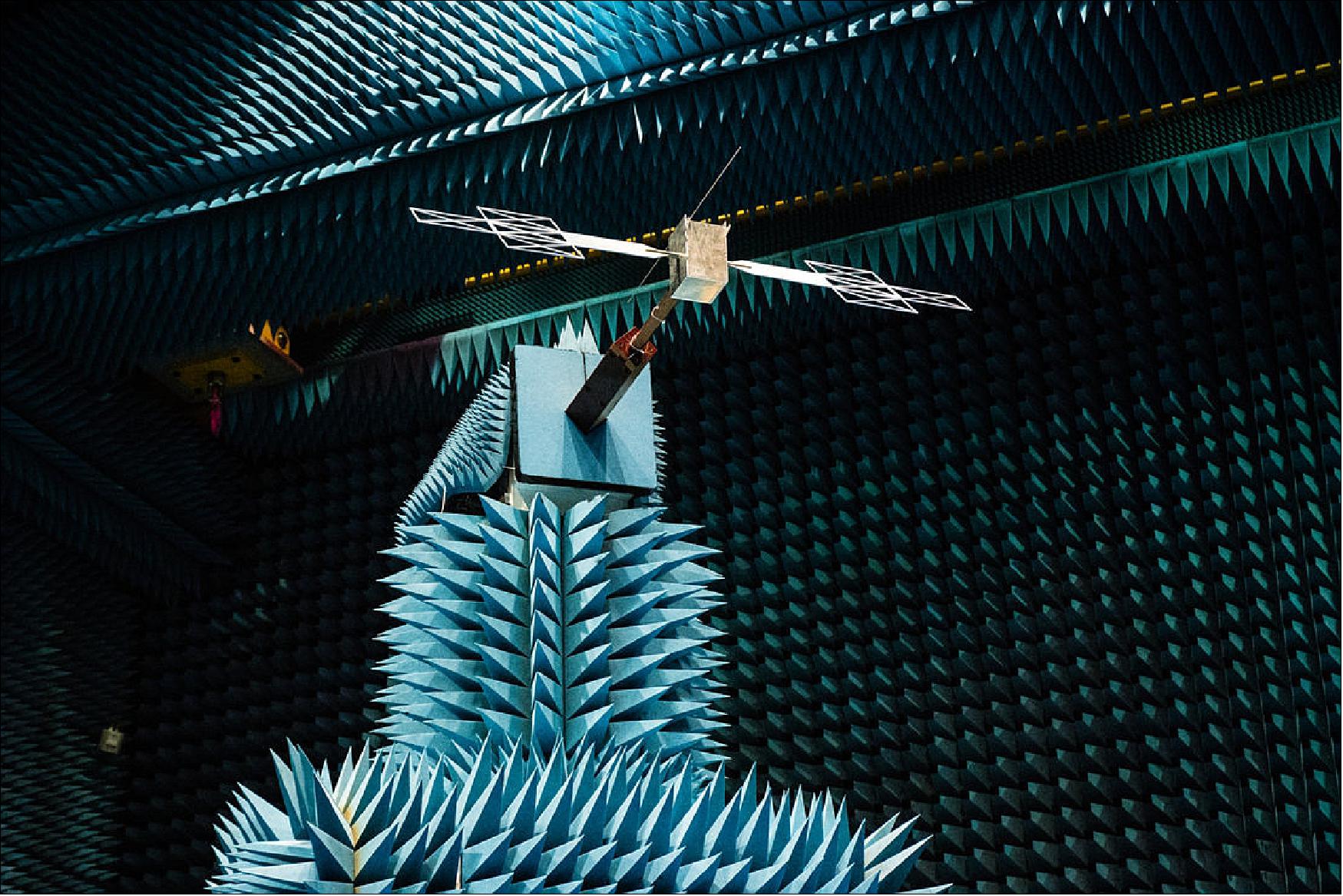
• June 7, 2018: One of the major challenges facing ESA's JUICE (JUpiter Icy Moon Explorer) will be the extreme temperatures that the spacecraft and its suite of instruments will have to endure. 39)
In order to ensure that the orbiter survives the voyage to Jupiter and the cold, hostile environment of the Solar System's largest planet, the spacecraft will have to pass a series of challenging tests during its lengthy development process. The first of these – known as a TDM (Thermal Development Model) test – was recently completed.
The objective of the test, which took place between 5 and 10 May at ESA/ESTEC in The Netherlands, was to verify that the spacecraft's thermal control system could protect the spacecraft from extreme temperatures during its complex mission.
After launch, JUICE will embark on an 88-month cruise that will make use of several flybys – of Earth, Venus, Earth, Mars, and again Earth – before leaving the inner Solar System on its way to Jupiter.
En route, the spacecraft will have to endure the effects of solar heating, particularly during the flyby of Venus. Eventually, it will have to operate in an extremely cold environment where some of its external surfaces will experience temperatures below -200º Celsius after arrival at Jupiter, with even colder conditions during solar eclipses, when the spacecraft will be in the planet's shadow.
The JUICE thermal control system is designed to minimize the impact of the external environment on the spacecraft through the use of high efficiency MLI (Multi-Layer Insulation). The material that is used to blanket the spacecraft's exterior is known as StaMet coated black kapton 160XC.
The MLI will moderate the external temperature during the spacecraft's closest approach to the Sun. It must also limit heat leakage in the cold Jupiter environment in order to minimize demand for power from the spacecraft's heaters, especially when its instruments are operating during the science and communication phases.
The power demand will be a crucial factor during operations given the limited power generated by the spacecraft's solar panels at Jupiter's distance from the Sun, where the amount of incoming solar energy is 25 times lower than on Earth.
Efficient passive thermal insulation also minimizes hardware mass – always a major concern for spacecraft designers – by reducing the need for radiators and heaters.
Thermal verification test: The thermal verification test was required to check the passive heat loss properties of the spacecraft in both cold and hot environments. It used a full scale model, the TDM, which comprised a simplified version of the JUICE flight model structure.
The spacecraft's central cylinder was replaced by a basic hexagonal structure and the HGA (High Gain Antenna) was simulated by a simple, white-painted aluminum disc with the same diameter as the HGA flight model. This was relevant for the test, because the HGA will be used as an umbrella shielding the structure when the spacecraft will be at its closest to the Sun.
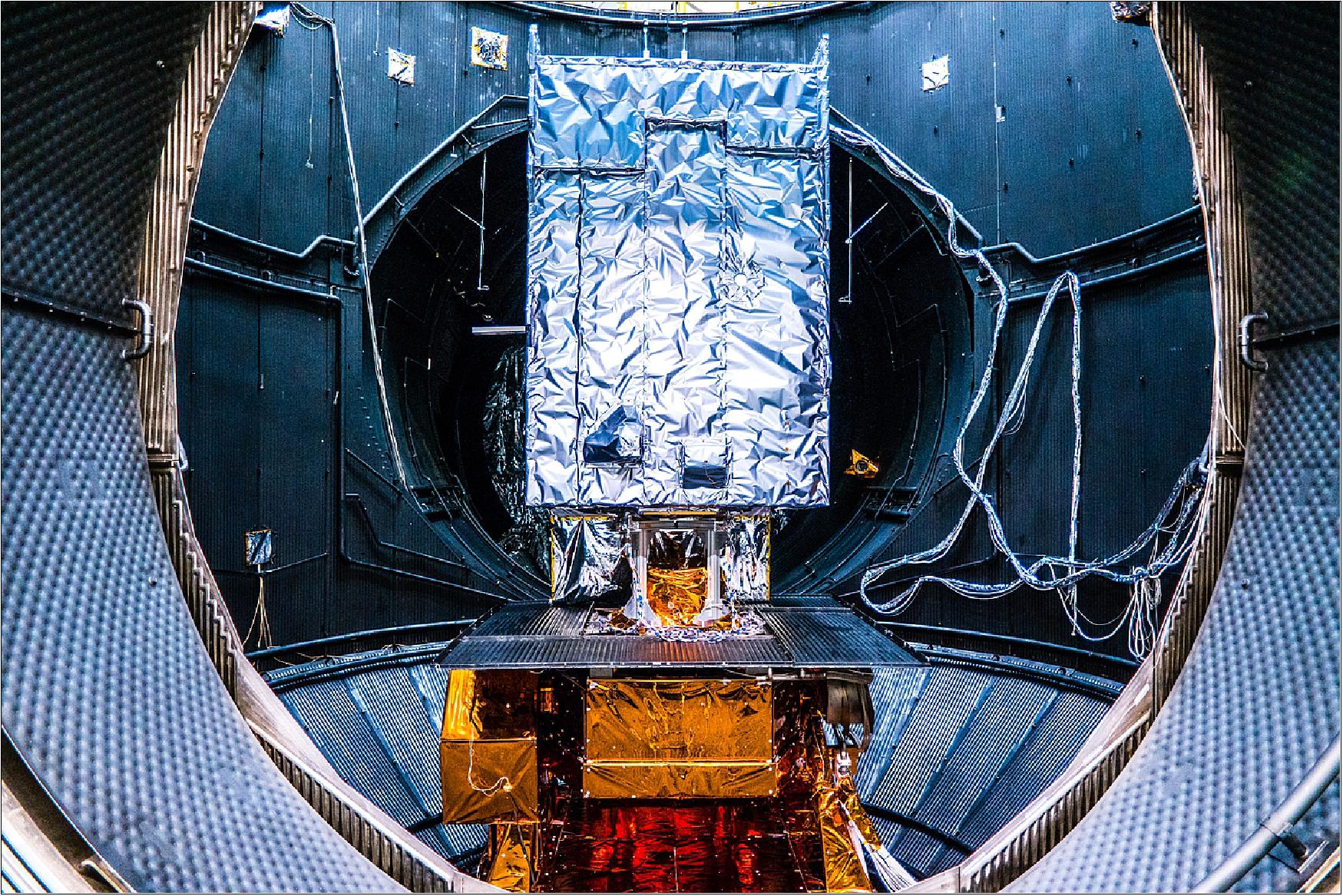
There were no other protruding instruments or appendages on the TDM, but heat dissipation from the platform and internal instruments was simulated by adding test heaters.
The TDM itself, wrapped in MLI, was placed in the LSS (Large Space Simulator) at ESA/ESTEC (European Space Research & Technology Centre) in Noordwijk, the Netherlands. Operated by European Test Services, the LSS is the largest space simulation facility in Europe, enabling a wide variety of tests to be performed on spacecraft.
Engineers began pumping the air out of the 9.4-m diameter chamber on 5 May, in order to create a vacuum comparable to the airless environment of deep space. This vacuum was maintained throughout the test.

• April 14, 2017: NASA's partnership in a future ESA (European Space Agency) mission to Jupiter and its moons has cleared a key milestone, moving from preliminary instrument design to implementation phase. 40)
- The April 6 milestone, known as Key Decision Point C (KDP-C), is the agency-level approval for the project to enter building phase. It also provides a baseline for the mission's schedule and budget. NASA's total cost for the project is $114.4 million. The next milestone for the NASA contributions will be the Critical Design Review (CDR), which will take place in about one year. The CDR for the overall ESA JUICE mission is planned in spring 2019.
- JUICE is a large-class mission—the first in ESA's Cosmic Vision 2015-2025 program carrying a suite of 10 science instruments. NASA will provide the UVS (Ultraviolet Spectrograph), and also will provide subsystems and components for two additional instruments: the PEP (Particle Environment Package) and the RIME (Radar for Icy Moon Exploration) experiment.
- The UVS was selected to observe the dynamics and atmospheric chemistry of the Jovian system, including its icy satellites and volcanic moon Io. With the planet Jupiter itself, the instrument team hopes to learn more about the vertical structure of its stratosphere and determine the relationship between changing magnetospheric conditions to observed auroral structures. The instrument is provided by the Southwest Research Institute (SwRI), at a cost of $41.2 million.
- The PEP is a suite of six sensors led by the Swedish Institute of Space Physics (IRF), capable of providing a 3-D map of the plasma system that surrounds Jupiter. One of the six sensors, known as PEP-Hi, is provided by the Johns Hopkins University Applied Physics Laboratory in Laurel, Maryland, and is comprised of two separate components known as JoEE and JENI. While JoEE is focused primarily on studying the magnetosphere of Ganymede, JENI observations will reveal the structure and dynamics of the donut-shaped cloud of gas and plasma that surrounds Europa. The total cost of the NASA contribution to the PEP instrument package is $42.4 million.
- The Radar for Icy Moon Exploration (RIME) experiment, an ice penetrating radar, which is a key instrument for achieving groundbreaking science on the geology, is led by the Italian Space Agency (ASI). NASA's Jet Propulsion Laboratory (JPL), in Pasadena, California, is providing key subsystems to the instrument, which is designed to penetrate the surface of Jupiter's icy moons to learn more about their subsurface structure. The instrument will focus on Callisto, Ganymede, and Europa, to determine the formation mechanisms and interior processes that occur to produce bodies of subsurface water. On Europa, the instrument also will search for thin areas of ice and locations with the most geological activity, such as plumes. The total cost of the NASA contribution is $30.8 million.
• March 15, 2017: Demanding electric, magnetic and power requirements, harsh radiation, and strict planetary protection rules are some of the critical issues that had to be tackled in order to move ESA's JUICE (Jupiter Icy Moons Explorer) from the drawing board and into construction. The PDR (Preliminary Design Review) is completed. 41)
• December 9, 2015: The mission was selected in May 2012 as the first Large-class mission within ESA's Cosmic Vision 2015–25 program. 42)
- For three and a half years, JUICE will sweep around Jupiter, exploring its turbulent atmosphere, enormous magnetosphere and tenuous set of dark rings, as well as studying the icy moons Ganymede, Europa and Callisto. It will eventually go into orbit around Ganymede, a first in Solar System exploration.
- All three of these planet-sized satellites are thought to have oceans of liquid water beneath their icy crusts and should provide clues on the potential for such moons to offer habitable environments.
- Airbus Defence & Space SAS in France was announced as the prime contractor in July when ESA approved the €350 million contract.
- The contract covers the design, development, integration, test, launch campaign and in-space commissioning of the spacecraft. The Ariane 5 launch is not included and will be procured later from Arianespace.
- The 10 state-of-the-art instruments were approved by ESA in February 2013 and are being developed by teams spanning 16 European countries, the USA and Japan, under national funding.
- The spacecraft will be assembled at Airbus Defence and Space GmbH in Friedrichshafen, Germany.
• In July 2015, Airbus DS was selected by ESA (European Space Agency) as prime contractor for the design, development, production, and testing of a new spacecraft named ‘JUICE'. As its name implies (Jupiter Icy Moons Explorer), the mission will be to explore the Jovian system, focusing on three of Jupiter's huge Galilean moons: Europa, Ganymede and Callisto, which are as large as dwarf planets and covered by an icy crust (Ref. 9).
Launch
As of 29 March 2022, ESA's Jupiter Icy Moons Explorer, Juice, is set to embark on an eight-year cruise to Jupiter starting in April 2023. The mission will investigate the emergence of habitable worlds around gas giants and the Jupiter system as an archetype for the numerous giant planets now known to orbit other stars. 43)
An Ariane 5 will lift Juice into space from Europe's Spaceport in Kourou. A series of gravity assist flybys of Earth, the Earth-Moon system and Venus will set the spacecraft on course for its July 2031 arrival at Jupiter. These flybys are shown here in order – Earth-Moon (August 2024), Venus (August 2025), Earth (September 2026, January 2029) – interspersed by Juice's continuing orbits around the Sun. Juice's flyby of the Earth-Moon system, known as a Lunar-Earth gravity assist (LEGA), is a world first: by performing this manoeuvre – a gravity assist flyby of the Moon followed just 1.5 days later by one of Earth – Juice will be able to save a significant amount of propellant on its journey.
Juice will start its science mission about six months prior to entering orbit around Jupiter, making observations as it approaches its destination. Once in the Jovian system, a gravity assist flyby of Jupiter's largest moon Ganymede – also the largest moon in the Solar System – will help Juice enter orbit around the gas giant. While in Jupiter orbit, the spacecraft will spend four years making detailed observations of Jupiter and three of its largest moons: Ganymede, Callisto and Europa.
During the tour, Juice will make two flybys of Europa (in July 2032), which has strong evidence for an ocean of liquid water under its icy shell. Juice will look at the moon's active zones, its surface composition and geology, search for pockets of liquid water under the surface, and study the plasma environment around Europa, also exploring the moon's tiny atmosphere and hunting for plumes of water vapour (as have been previously detected erupting to space).
A sequence of Callisto flybys will not only be used to study this ancient, cratered world that may too harbour a subsurface ocean, but will also change the angle of Juice's orbit with respect to Jupiter's equator, making it possible to investigate the polar regions and environment of Jupiter at higher latitudes (2032–2034).
A sequence of Ganymede and Callisto flybys will adjust Juice's orbit – properly orienting it while minimising the amount of propellant expended – so that it can enter orbit around Ganymede in December 2034, making it the first spacecraft to orbit another planet's moon. Juice's initial elliptical orbit will be followed by a 5000 km-altitude circular orbit, and later a 500 km-altitude circular orbit.
A sequence of Ganymede and Callisto flybys will adjust Juice's orbit – properly orienting it while minimising the amount of propellant expended – so that it can enter orbit around Ganymede in December 2034, making it the first spacecraft to orbit another planet's moon. Juice's initial elliptical orbit will be followed by a 5000 km-altitude circular orbit, and later a 500 km-altitude circular orbit.
Over time, Juice's orbit around Ganymede will naturally decay – eventually there will not be enough propellant to maintain it – and it will make a grazing impact onto the surface (late 2035). The animation concludes with an example of what the approach to impact could look like.
Sensor Complement (3GM, Gala, JANUS, J-MAG, MAJIS, PEP, PRIDE, RIME, RPWI, SWI, UVS)
ESA's Jupiter Icy Moons Explorer, Juice, will carry the most powerful remote sensing, geophysical, and in situ payload complement ever flown to the outer Solar System.
The payload consists of 10 state-of-the-art instruments plus one experiment that uses the spacecraft telecommunication system with ground-based instruments. This payload is capable of addressing all of the mission's science goals, from in situ measurements of Jupiter's atmosphere and plasma environment, to remote observations of the surface and interior of the three icy moons, Ganymede, Europa and Callisto.
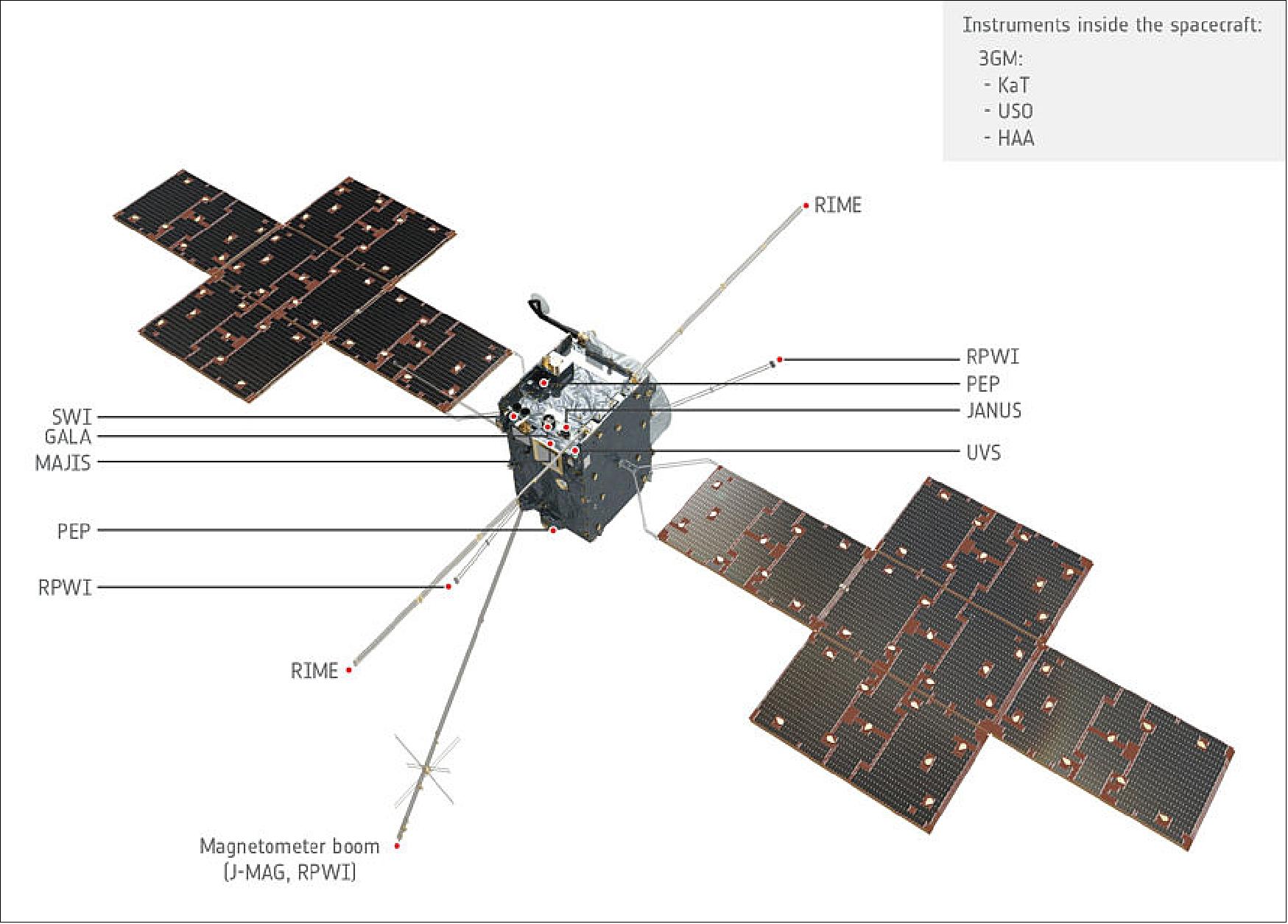
3GM (Gravity & Geophysics of Jupiter and Galilean Moons)
The instrument is a radio package comprising the KaT (Ka-Transponder), USO (ultrastable oscillator) and HAA (High Accuracy Accelerometer). The experiment will study the gravity field at Ganymede, the extent of the internal oceans on the icy moons, and the structure of the neutral atmosphere and ionosphere of Jupiter (0.1 - 800 mbar) and its moons.
PI: L. Iess, Università di Roma "La Sapienza", Italy. Lead funding agency: ASI.
GALA (GAnymede Laser Altimeter)
GALA will study the tidal deformation of Ganymede and the topography of the surfaces of the icy moons. GALA will have a 20 m spot size and 0.1 m vertical resolution at 200 km.
PI: H. Hussmann, DLR, Institut für Planetenforschung, Germany. Lead funding agency: DLR.
JANUS (optical camera system)
JANUS will study global, regional and local features and processes on the moon, as well as map the clouds of Jupiter. It will have 13 filters, a FOV of 1.3º, and spatial a resolution up to 2.4 m on Ganymede and about 10 km at Jupiter.
PI: P. Palumbo, Università degli Studi di Napoli "Parthenope", Italy. Lead funding agency: ASI.
J-MAG (JUICE Magnetometer)
J-MAG is equipped with sensors to characterize the Jovian magnetic field and its interaction with that of Ganymede, and to study the subsurface oceans of the icy moons. The instrument will use fluxgates (inbound and outbound) sensors mounted on a boom.
PI: M. Dougherty, Imperial College London, United Kingdom. Lead funding agency: UKSA, United Kingdom.
MAJIS (Moons and Jupiter Imaging Spectrometer)
MAJIS will observe cloud features and atmospheric constituents on Jupiter, and will characterize ices and minerals on the icy moon surfaces. MAJIS will cover the visible and infrared wavelengths from 0.4 to 5.7 µm, with spectral resolution of 3-7 nm. The spatial resolution will be up to 25 m on Ganymede and about 100 km on Jupiter.
PI: Y. Langevin, Institut d'Astrophysique Spatiale, France. Lead funding agency: CNES.
PEP (Particle Environment Package)
PEP comprises a package of sensors to characterize the plasma environment of the Jovian system. PEP will measure density and fluxes of positive and negative ions, electrons, exospheric neutral gas, thermal plasma and energetic neutral atoms in the energy range from <0.001 eV to >1 MeV with full angular coverage. The composition of the moons' exospheres will be measured with a resolving power of more than 1000.
PI: S. Barabash, Swedish Institute of Space Physics (Institutet för rymdfysik, IRF), Kiruna, Sweden. Lead funding agency: SNSB, Sweden.
PRIDE (Planetary Radio Interferometer & Doppler Experiment)
PRIDE will use the standard telecommunication system of the spacecraft, together with radio telescopes on Earth, VLBIs (Very Long Baseline Interferometry systems), to perform precise measurements of the spacecraft position and velocity to investigate the gravity fields of Jupiter and the icy moons.
PI: L. Gurvits, Joint Institute for VLBI in Europe, The Netherlands. Lead funding agency: NWO (Dutch Research Council) and NSO (Netherlands Space Office), The Netherlands.
RIME (Radar for Icy Moons Exploration)
RIME is an ice-penetrating radar to study the subsurface structure of the icy moons down to a depth of around nine kilometers with vertical resolution of up to 30 m in ice. RIME will work at a central frequency of 9 MHz (1 and 3 MHz bandwidth) and will use a 16 m antenna.
PI: L. Bruzzone, Università degli Studi di Trento, Italy. Lead funding agency: ASI.
The transmitter of RIME, developed and built by NASA/JPL, is shown in Figure 16.
RPWI (Radio and Plasma Wave Investigation)
The instrument will characterize the radio emission and plasma environment of Jupiter and its icy moons using a suite of sensors and probes.
RPWI will be based on four experiments, GANDALF, MIME, FRODO, and JENRAGE. It will use a set of sensors, including two Langmuir probes to measure DC electric field vectors up to a frequency of 1.6 MHz and to characterize thermal plasma and medium- and high-frequency receivers, and antennas to measure electric and magnetic fields in radio emission in the frequency range 80 kHz- 45 MHz.
PI: J.-E. Wahlund, Swedish Institute of Space Physics (Institutet för rymdfysik, IRF), Uppsala, Sweden. Lead funding agency: SNSB, Sweden.
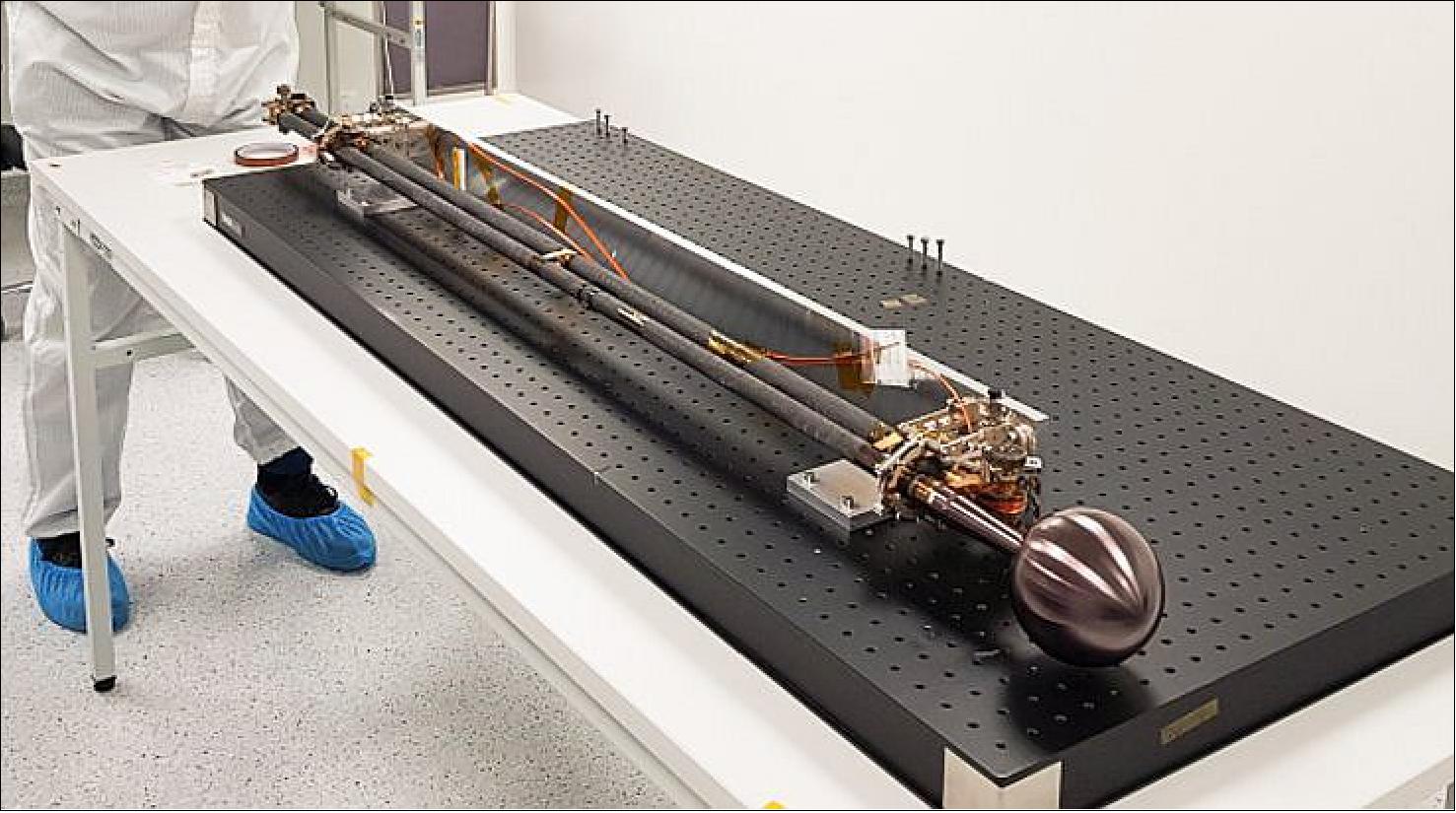
SWI (Sub-millimeter Wave Instrument)
The objective of SWI is to investigate the temperature structure, composition and dynamics of Jupiter's atmosphere, and the exospheres and surfaces of the icy moons. SWI is a heterodyne spectrometer using a 30 cm antenna and working in two spectral ranges 1080-1275 GHz and 530-601 GHz with spectral resolving power of ~107.
PI: P. Hartogh, Max-Planck-Institut für Sonnensystemforschung, Germany. Lead funding agency: DLR, Germany.
UVS (UV imaging Spectrograph)
The aim of UVS is to characterize the composition and dynamics of the exospheres of the icy moons, to study the Jovian aurorae, and to investigate the composition and structure of the planet's upper atmosphere. The instrument will perform both nadir observations and solar and stellar occultation sounding.
UVS will cover the wavelength range 55-210 nm with a spectral resolution of <0.6 nm. The spatial resolution will reach 0.5 km at Ganymede and up to 250 km at Jupiter.
PI: R. Gladstone, SwRI (Southwest Research Institute), USA. Lead funding agency: NASA.
References
2) "JUICE definition study report (Red Book)," ESA/SRE(2014)1, Issue 1, September 2014, URL: https://sci.esa.int/documents/33960/35865/1567260128466-JUICE_Red_Book_i1.0.pdf
3) "Science Objectives," ESA, URL: https://www.cosmos.esa.int/web/juice/science-objectives
4) O. Grasset, M. K. Dougherty, A. Coustenis, E. J. Bunce, C. Erd,D. Titov, M. Blanc, A. Coates,P. Drossart, L. N. Fletcher, H. Hussmann, R. Jaumann, N. Krupp, J.-P. Lebreton, O. Prieto-Ballesteros, P. Tortora, F. Tosi, T. Van Hoolst, "JUpiter ICy moons Explorer (JUICE): An ESA mission to orbit Ganymede and to characterize the Jupiter system," Planetary and Space Science, Volume 78, April 2013, Pages 1-21, URL: https://doi.org/10.1016/j.pss.2012.12.002
5) Pablo Hermosín, Javier Martín, Simone Centuori, Eric Ecale, Arnaud Boutonnet, Christian Erd, "JUICE planetary protection analysis," Proceedings of the 70th IAC (International Astronautical Congress), Washington DC, USA, 21-25 October 2019, paper: IAC-19,A3,5,4, URL: https://iafastro.directory/iac/proceedings/IAC-19/IAC-19/A3/5/manuscripts/IAC-19,A3,5,4,x52942.pdf
6) "JUICE is Europe's next large science mission," ESA, 2 May 2012, URL: http://m.esa.int/Our_Activities/Space_Science/JUICE_is_Europe_s_next_large_science_mission
7) "New evidence of watery plumes on Jupiter's moon Europa," ESA science & Exploration, 12 May 2020, URL: http://www.esa.int/ESA_Multimedia/Images/2020/05/New_evidence_of_watery_plumes_on_Jupiter_s_moon_Europa
8) H. L. F. Huybrighs, E. Roussos, A. Blöcker, N. Krupp, Y. Futaana, S. Barabash, L. Z. Hadid, M. K. G. Holmberg, O. Lomax, O. Witasse, "An Active Plume Eruption on Europa During Galileo Flyby E26 as Indicated by Energetic Proton Depletions," Geophysical Research Letters, Volume47, Issue10, 28 May 2020, e2020GL08780, https://doi.org/10.1029/2020GL087806
9) Juice - Searching for life on jupiter's icy moons," Airbus, July 2015, URL: http://www.airbus.com/space/space-exploration/juice-searching-for-life-on-jupiters-icy-moons.html
10) "JUICE starts its journey ... on Earth," Airbus Press Release, 25 July 2019, URL: https://web.archive.org/web/20210804002508/https://www.airbus.com/newsroom/press-releases/en/2019/07/juice-starts-its-journey-on-earth.html
11) "Spacecraft," URL: https://www.cosmos.esa.int/web/juice/spacecraft
12) "JUICE ground control gets green light to start development of Jupiter operations," ESA, 16 January 2018, URL: http://sci.esa.int/juice/59935-juice-ground-control-gets-green-light-to-start-development-of-jupiter-operations/
13) P. Zanella, F. Faleg, M. Molina, A. Polli, S. Riva, E. Ferrando, R. Romani, E. Bongers, M. Kroon, H. Klinkspoor,T. Boers, T. Schirmann, C. Lebranchu, C. Sabourin, A. Calvel , S. Verstaen, C. Baur, "The JUICE Photovoltaic Assembly," Proceedings of the 69th IAC (International Astronautical Congress) Bremen, Germany, 1-5 October 2018, paper: IAC-18-C3.4.4, URL: https://iafastro.directory/iac/proceedings/IAC-18/IAC-18/C3/4/manuscripts/IAC-18,C3,4,4,x43899.pdf
14) "Jupiter's moon Europa to obscure distant star," ESA Science & Exploration, 7 June 2022, URL: https://www.esa.int/Science_Exploration/Space_Science/Gaia/Jupiter_s_moon_Europa_to_obscure_distant_star
15) "Juice spacecraft fully integrated and ready for next testing," ESA Science & Exploration, 20 May 2022, URL: https://www.esa.int/ESA_Multimedia/Videos/2022/04/Juice_spacecraft_fully_integrated_and_ready_for_next_testing
16) "Testing radar to peer into Jupiter's moons," ESA, 22 December 2021, URL: https://www.esa.int/ESA_Multimedia/Images/2021/12/Testing_radar_to_peer_into_Jupiter_s_moons
17) "Jupiter mission passes space vacuum test," ESA Enabling & Support, 29 July 2021, URL: https://www.esa.int/ESA_Multimedia/Images/2021/07/Jupiter_mission_passes_space_vacuum_test
18) "The Making of JUICE - Episode 5," ESA Science & Exploration, 7 July 2021, URL: https://www.esa.int/ESA_Multimedia/Videos/2021/07/The_Making_of_JUICE_-_Episode_5
19) "Ultra-cool test of Jupiter instrument," ESA Science & Exploration, 15 June 2021, URL: https://www.esa.int/ESA_Multimedia/Videos/2021/06/Ultra-cool_test_of_Jupiter_instrument
20) "Juice moves into Large Space Simulator," ESA Science & Exploration, 14 June 2021, URL: https://www.esa.int/Science_Exploration/Space_Science/Juice_moves_into_Large_Space_Simulator
21) "Jupiter antenna that came in from the cold," ESA Enabling & Support, 27 May 2021, URL: https://www.esa.int/ESA_Multimedia/Images/2021/05/Jupiter_antenna_that_came_in_from_the_cold
22) "Juice arrives at ESA's technical heart," ESA Science & Exploration, 6 May 2021, URL: https://www.esa.int/Science_Exploration/Space_Science/Juice_arrives_at_ESA_s_technical_heart
23) "Teach with Jupiter educational webpage now online," ESA / Education / Teach with Jupiter, 8 February 2021, URL: https://www.esa.int/Education/Teach_with_Jupiter/Teach_with_Jupiter_educational_webpage_now_online
24) "Juice solar panels ready to turn into wings," ESA Science & Exploration, 16 October 2020, URL: https://www.esa.int/ESA_Multimedia/Images/2020/10/Juice_solar_panels_ready_to_turn_into_wings
25) "JPL Meets Unique Challenge, Delivers Radar Hardware for Jupiter Mission," NASA/JPL, 21 September 2020, URL: https://www.jpl.nasa.gov/news/news.php?release=2020-182
26) "#6: Start of assembly and integration for JUICE," ESA Science & Technology, 26 June 2020, URL: https://sci.esa.int/web/juice/-/-6-start-of-assembly-and-integration-for-juice
27) "Jupiter explorer Juice arrives for final integration," ESA Science & Exploration, 23 April 2020, URL: http://www.esa.int/Science_Exploration/Space_Science/Jupiter_explorer_Juice_arrives_for_final_integration
28) "First instrument delivered for Jupiter Icy Moon Explorer," ESA Science & Exploration, 25 February 2020, URL: http://www.esa.int/ESA_Multimedia/Images/2020/02/First_instrument_delivered_for_Jupiter_Icy_Moon_Explorer
29) "Airborne delivers final XL panels to Airbus for JUICE solar array," Solar Daily, URL: http://www.solardaily.com/reports/Airborne_delivers_final_XL_substrate_panels_to_Airbus_DS_NL_for_solar_array_of_ESAs_JUICE_mission_999.html
30) Juice cast in gold," ESA Science & Exploration, 4 November 2019, URL: http://www.esa.int/ESA_Multimedia/Images/2019/11/Juice_cast_in_gold
31) "#5: JUICE begins to take shape," ESA Science & Technology, 23 October 2019, URL: https://sci.esa.int/web/juice/-/-5-juice-begins-to-take-shape
32) "CERN simulating Jupiter," ESA, 28 August 2019, URL: http://www.esa.int/spaceinimages/Images/2019/08/CERN_s_VESPER_facility
33) "Jupiter mission takes first images of destination – from Earth!," ESA, 22 August 2019, URL: http://www.esa.int/Our_Activities/Space_Science/Jupiter_mission_takes_first_images_of_destination_from_Earth
34) "Arianespace and ESA announce Jupiter Icy Moons Explorer launch contract," ESA Space Science, 17 June 2019, URL: http://www.esa.int/Our_Activities/Space_Science/Arianespace_and_ESA_announce_Jupiter_Icy_Moons_Explorer_launch_contract
35) "Review board gives JUICE the all clear," ESA, 3 April 2019, URL: http://sci.esa.int/juice/61286-review-board-gives-juice-the-all-clear/
36) "Juice's magnetometer boom," ESA, Technology image of the week, 20 March 2019, URL: http://m.esa.int/spaceinimages/Images/2019/03/Juice_s_magnetometer_boom
37) "JUICE engineering model ready for testing," ESA Science & Technology, 11 December 2018, URL: http://sci.esa.int/juice/60968-4-juice-engineering-model-ready-for-testing/
38) "Testing the radar antenna for Juice," ESA, 12 November 2018: URL: http://m.esa.int/spaceinimages/Images/2018/11/Testing_the_radar_antenna_for_Juice
39) "#1: JUICE comes in from extreme temperature test," ESA, 7 June 2018, URL: http://sci.esa.int/juice/60393-1-juice-comes-in-from-extreme-temperature-test/
40) "NASA Approves Instruments for ESA's ‘JUICE' Mission to Jupiter System," NASA 14 April 2017, URL: https://www.nasa.gov/feature/nasa-approves-instruments-for-esa-s-juice-mission-to-jupiter-system
41) "ESA's Jupiter mission moves off the drawing board," ESA, 15 March 2017, URL: https://sci.esa.int/web/juice/-/58887-esa-s-jupiter-mission-moves-off-the-drawing-board
42) "Jupiter mission contract ceremony — ESA and Airbus Defence & Space today marked the signing of the contract for building JUICE, the JUpiter ICy moons Explorer," ESA, 9 December 2015, URL: http://sci.esa.int/juice/57014-jupiter-mission-contract-ceremony/
43) "Juice's journey and Jupiter system tour," ESA Science & Exploration, 29 March 2022, URL: https://www.esa.int/ESA_Multimedia/Videos/2022/03/Juice_s_journey_and_Jupiter_system_tour
44) "JUICE Science Payload," ESA, Science & Technology, 5 February 2019, URL: http://sci.esa.int/juice/50073-science-payload/
45) "Swedish space technology ready to explore oceans under the ice on Jupiter's moon Ganymede," IRF (Swedish Institute of Space Physics) Press Release, 21 August 2020, URL: https://www.irf.se/en/news/2020/08/21/swedish-space-technology-ready-to-explore-oceans-under-the-ice-on-jupiters-moon-ganymede/
The information compiled and edited in this article was provided by Herbert J. Kramer from his documentation of: "Observation of the Earth and Its Environment: Survey of Missions and Sensors" (Springer Verlag) as well as many other sources after the publication of the 4th edition in 2002.
Spacecraft Development Status Launch Sensor Complement References Back to Top